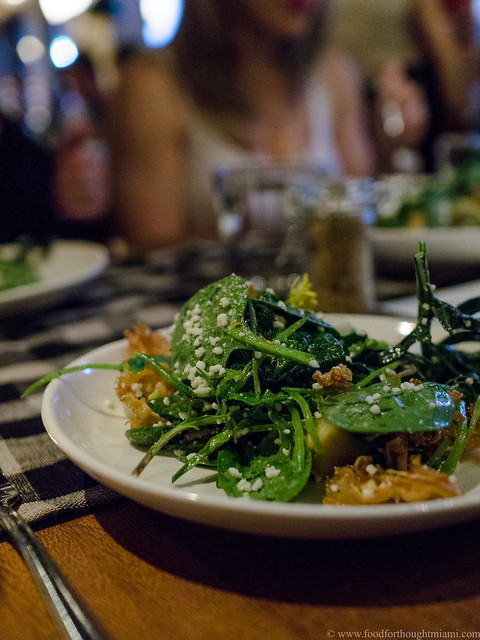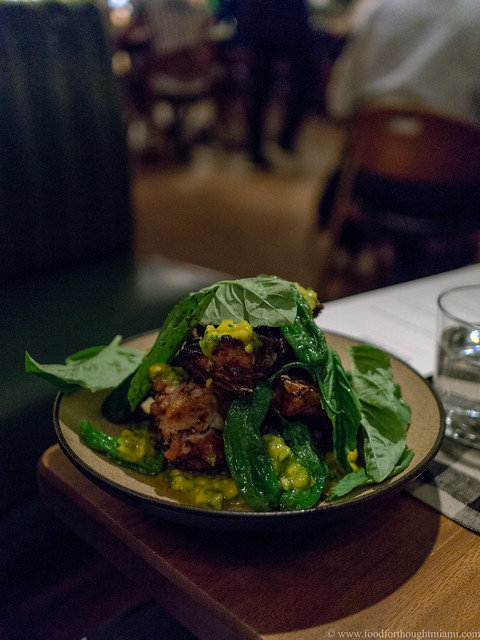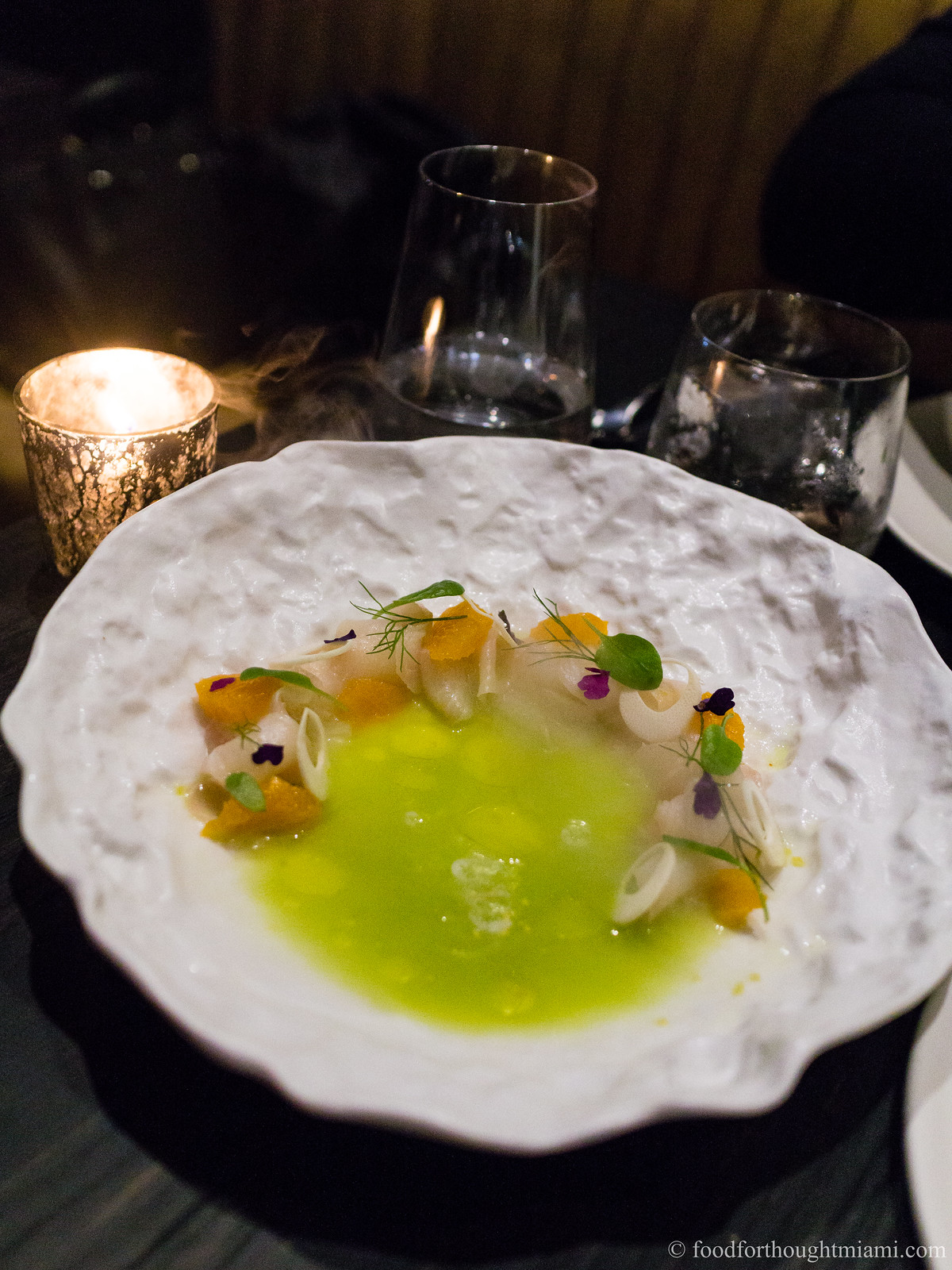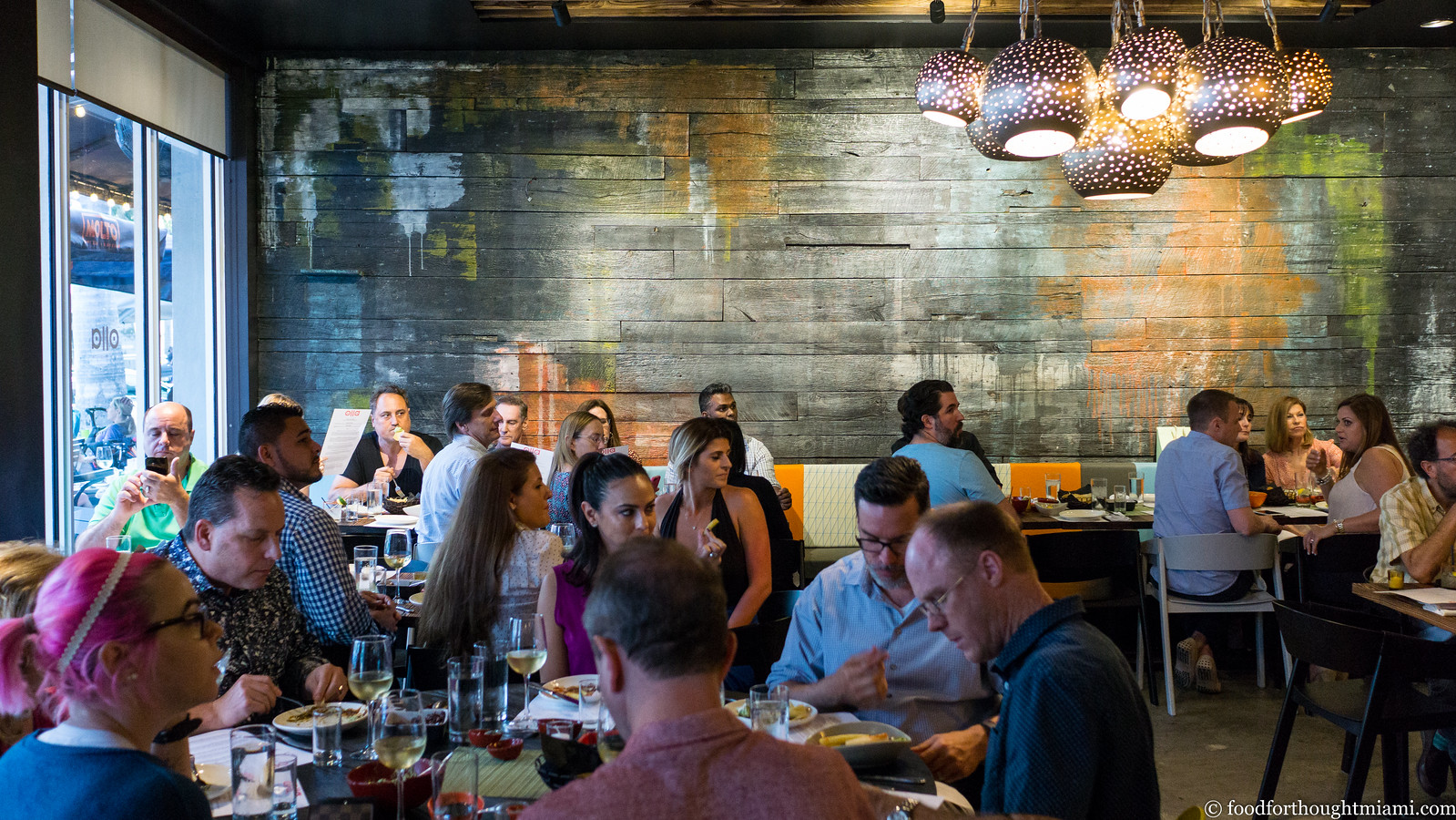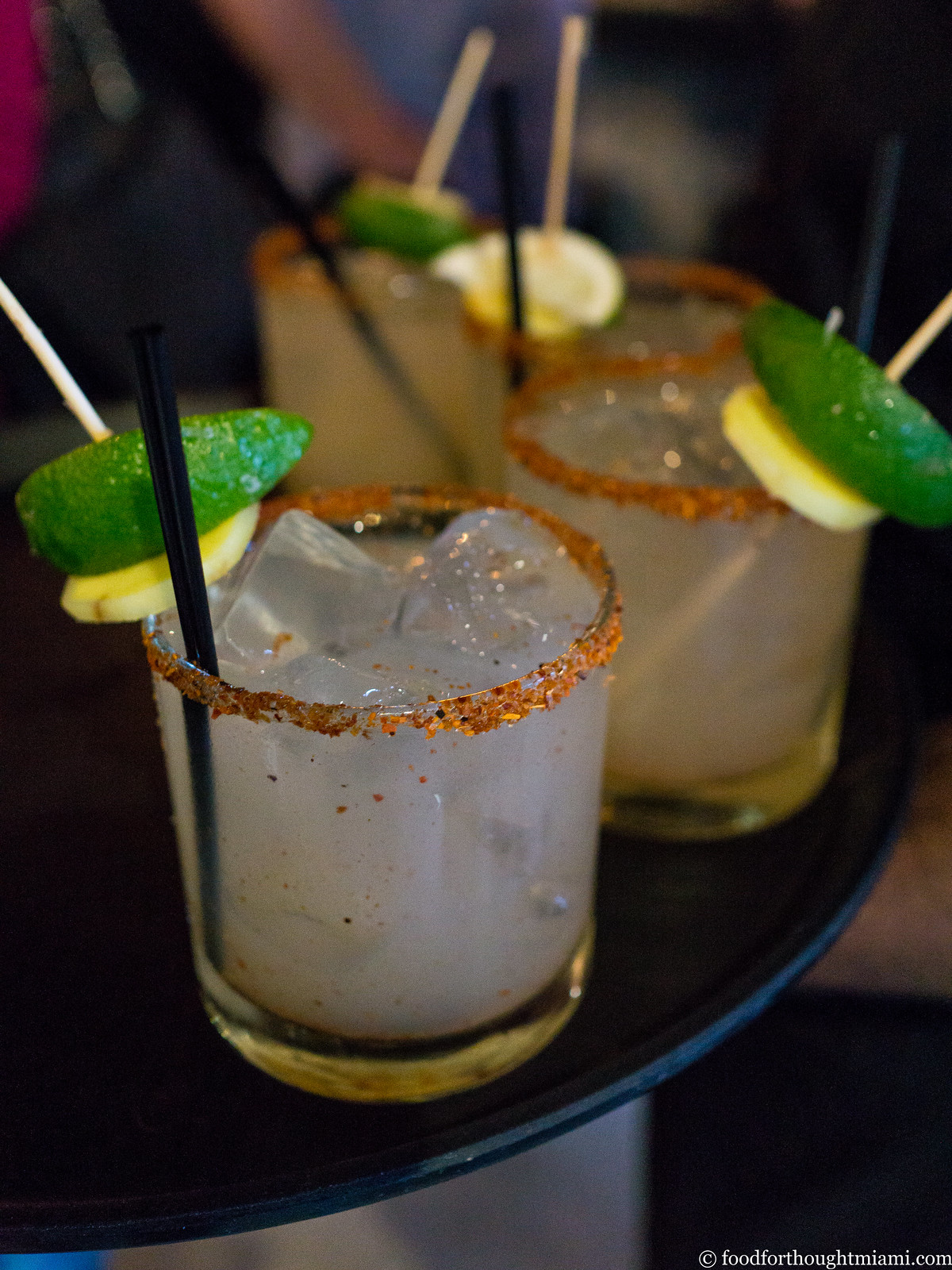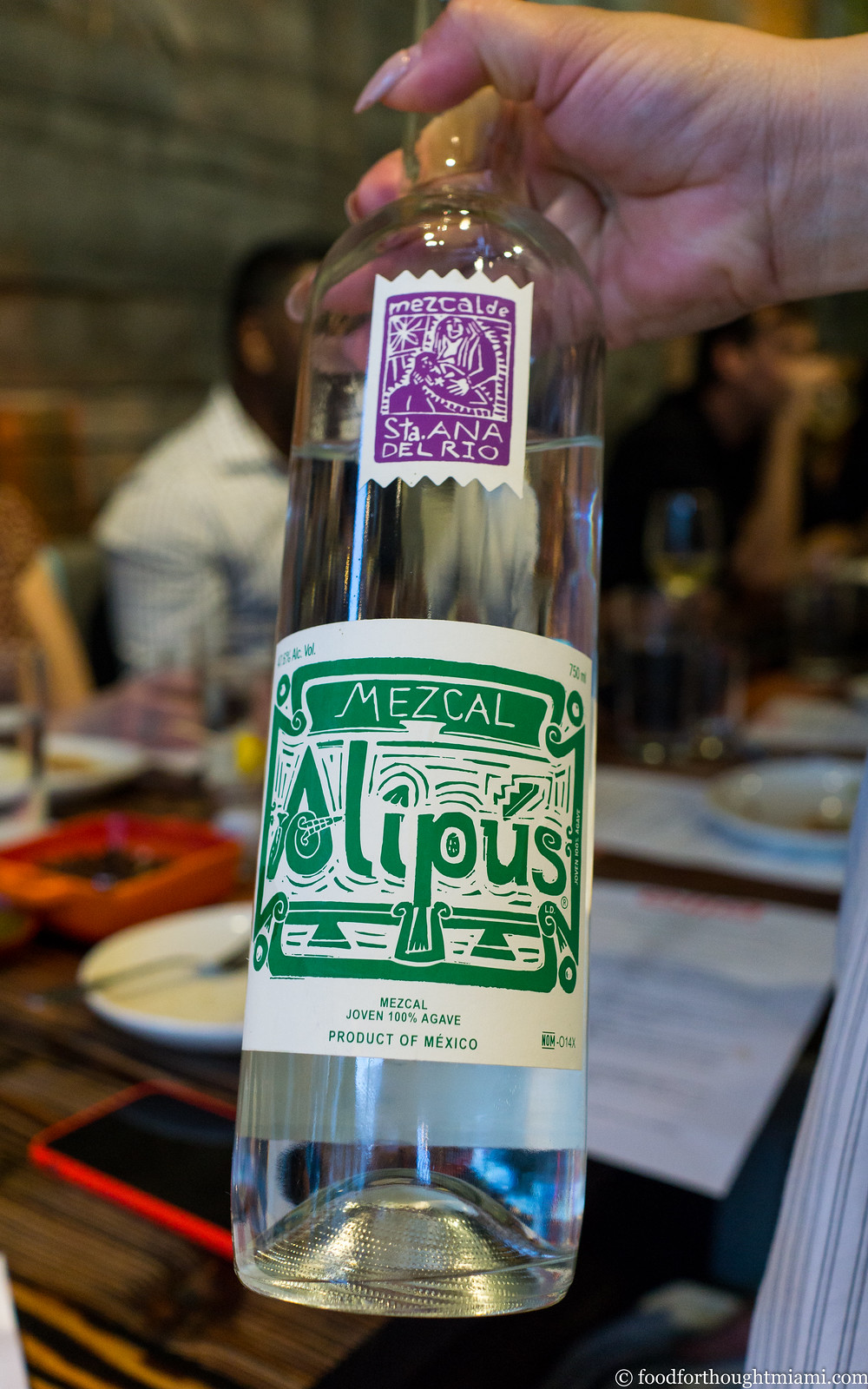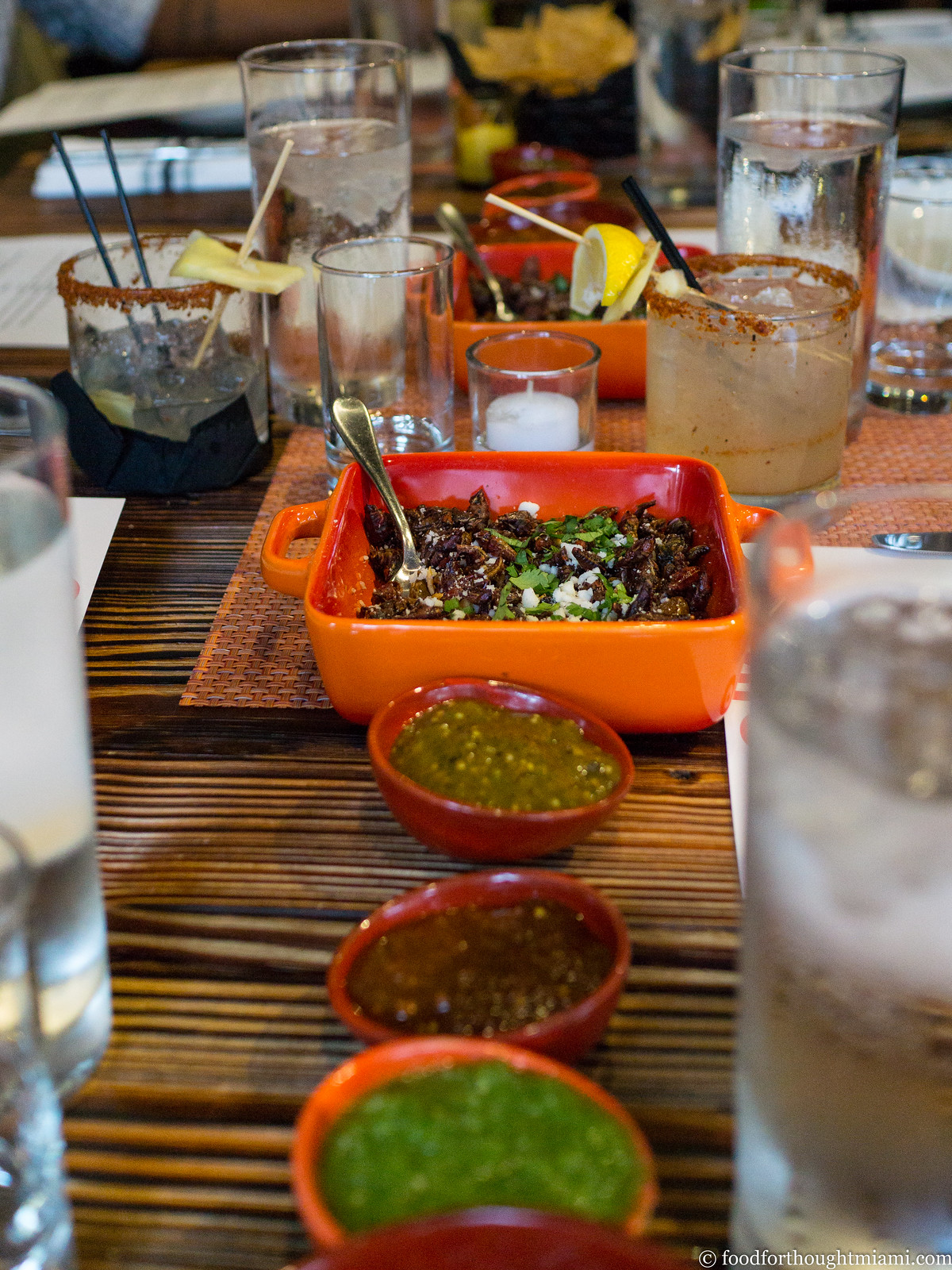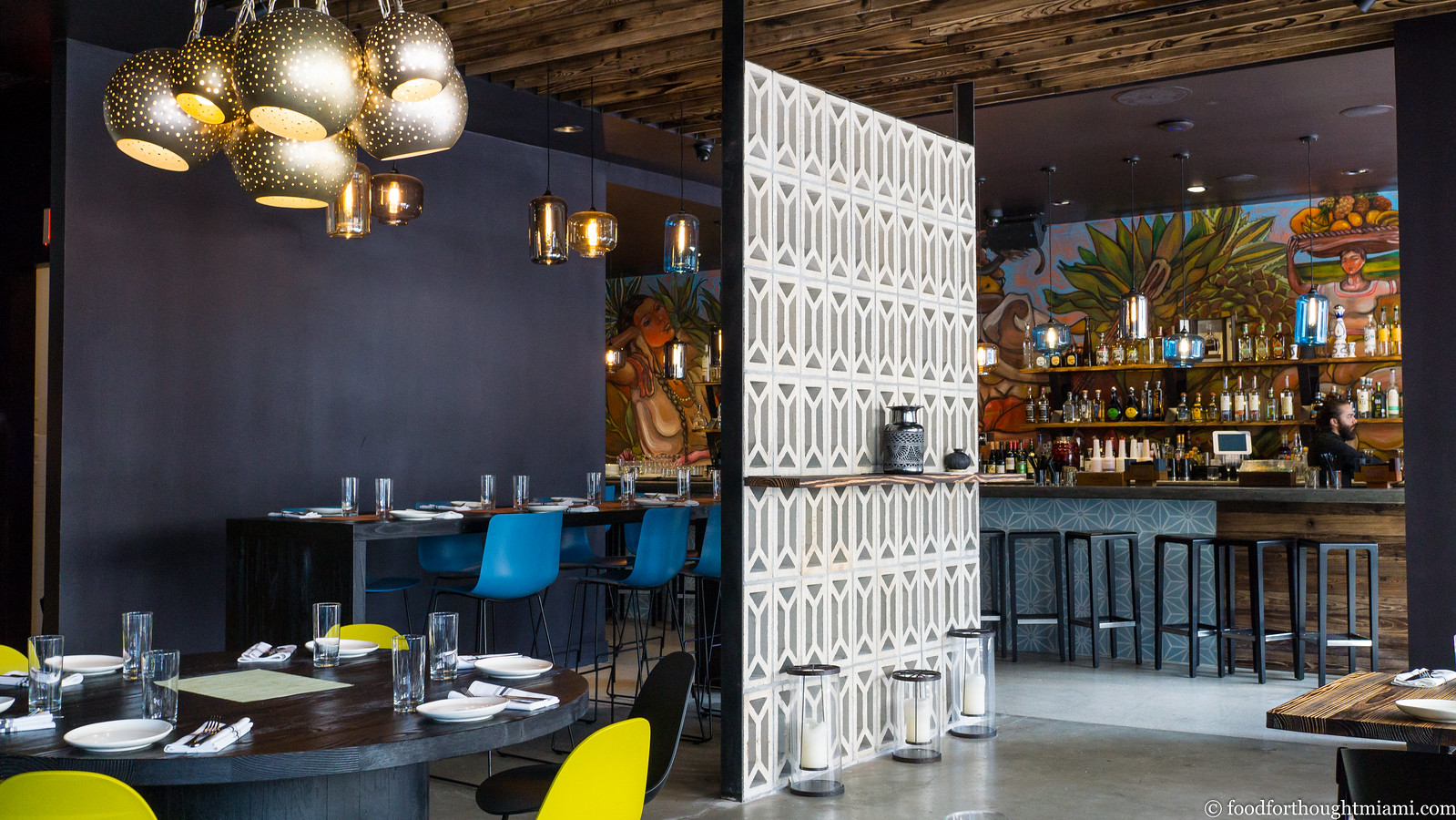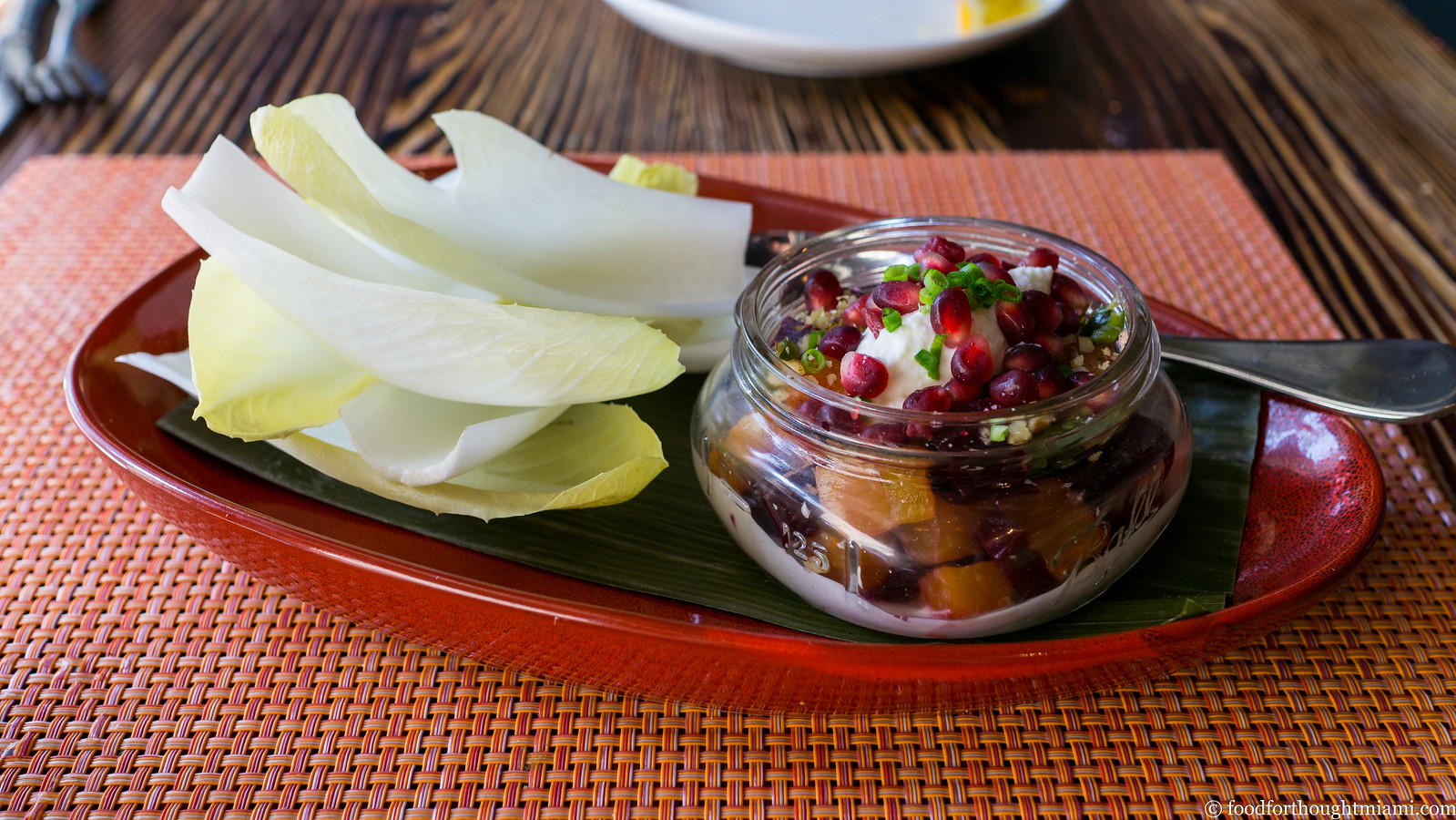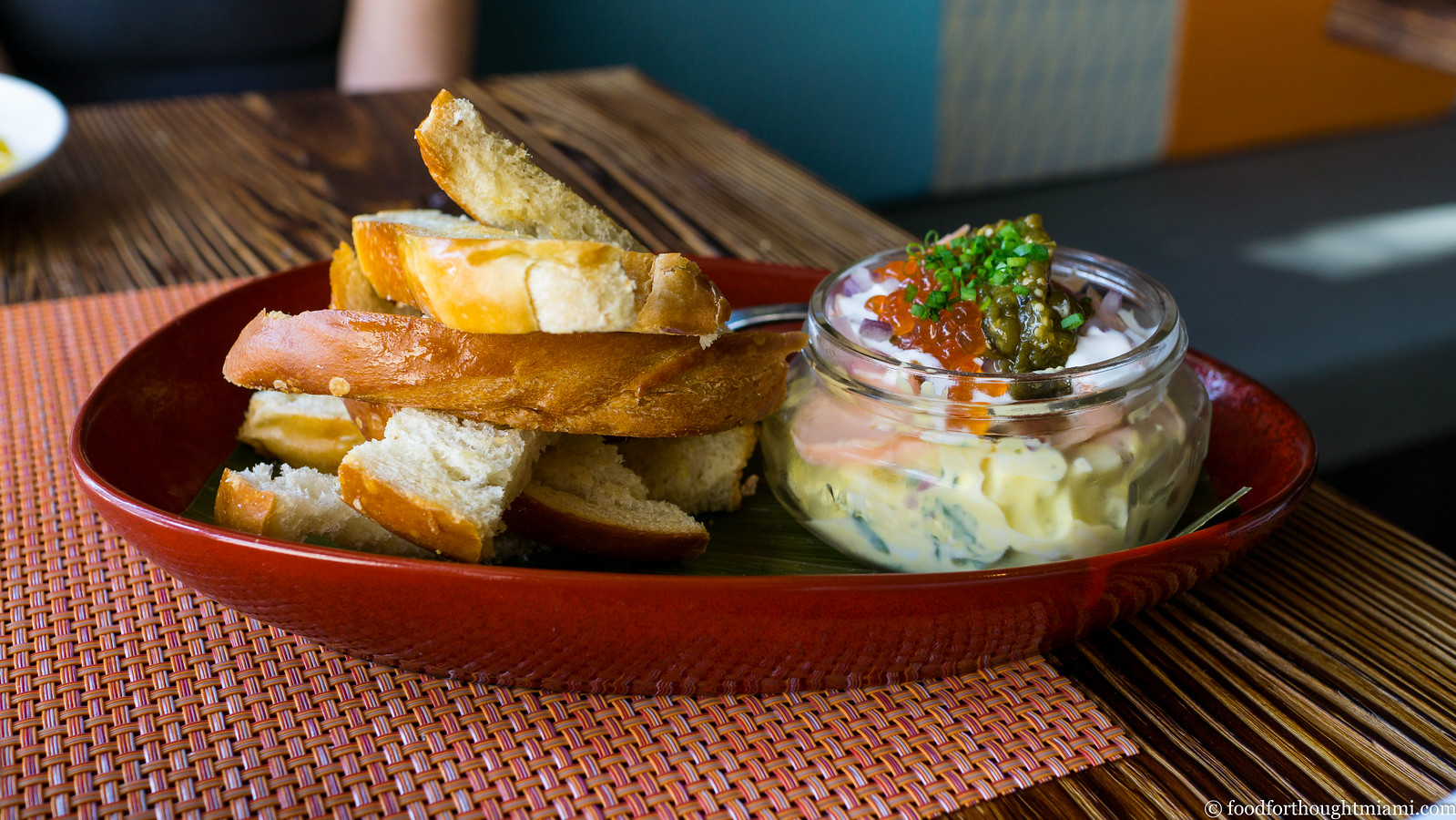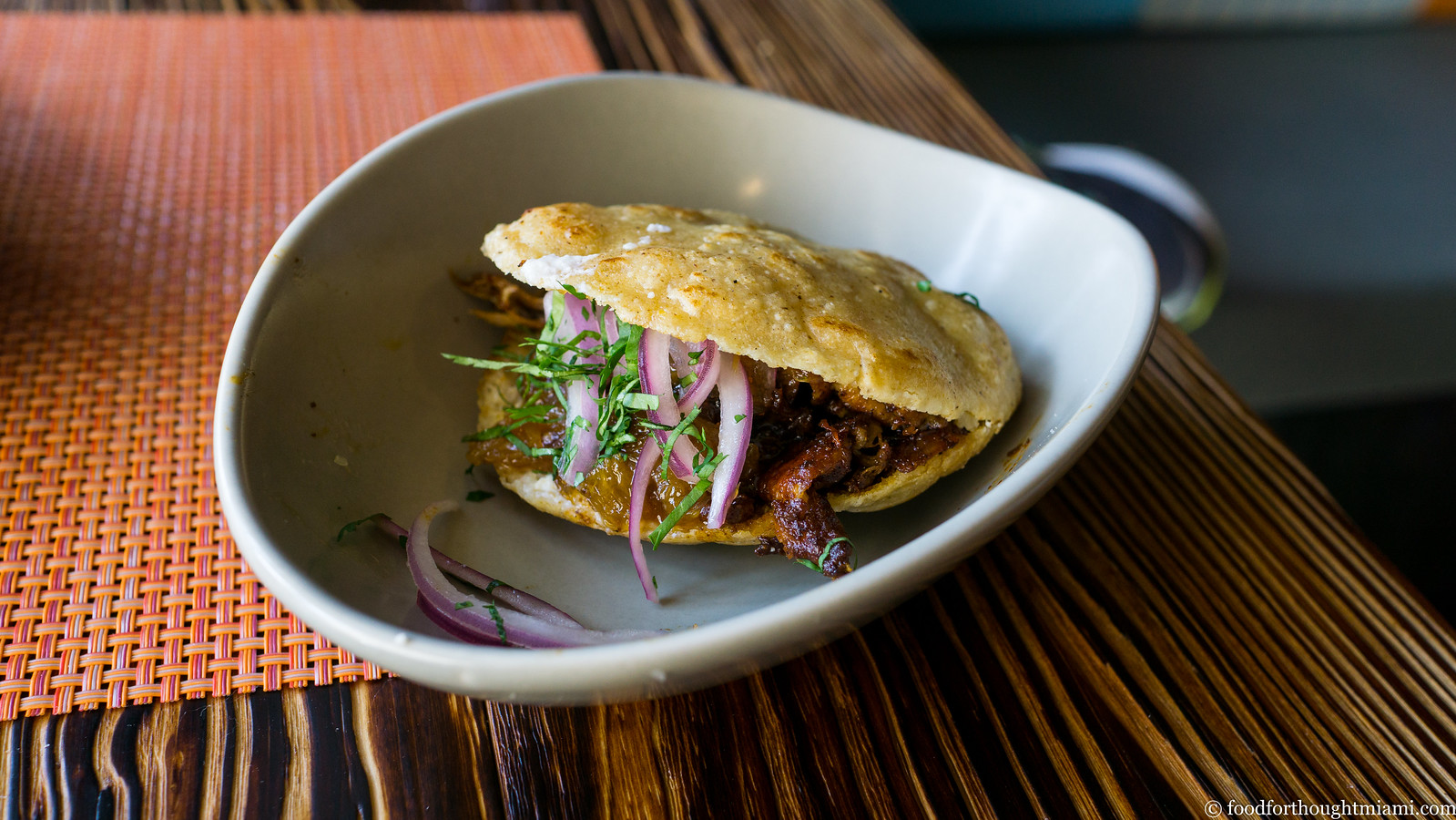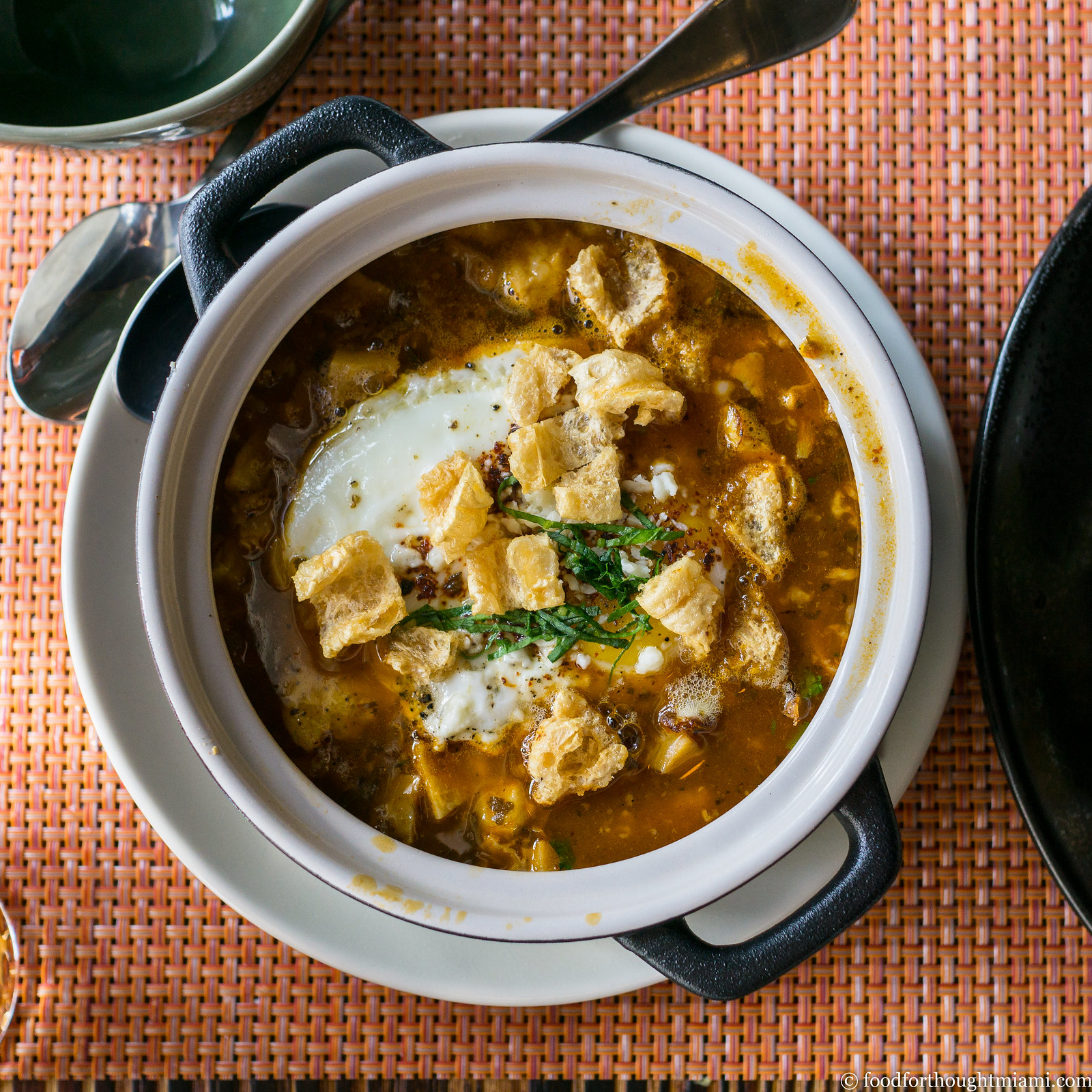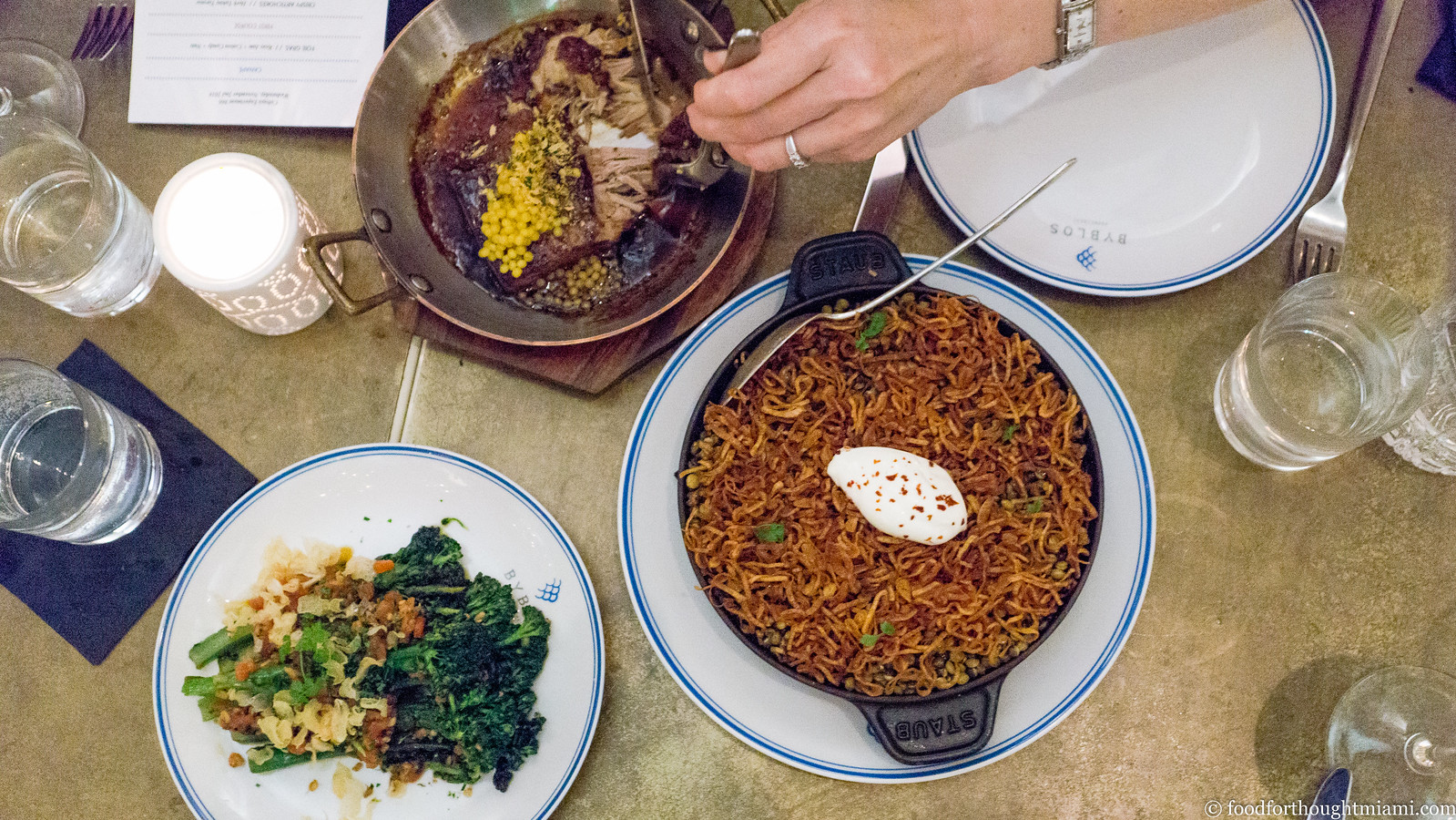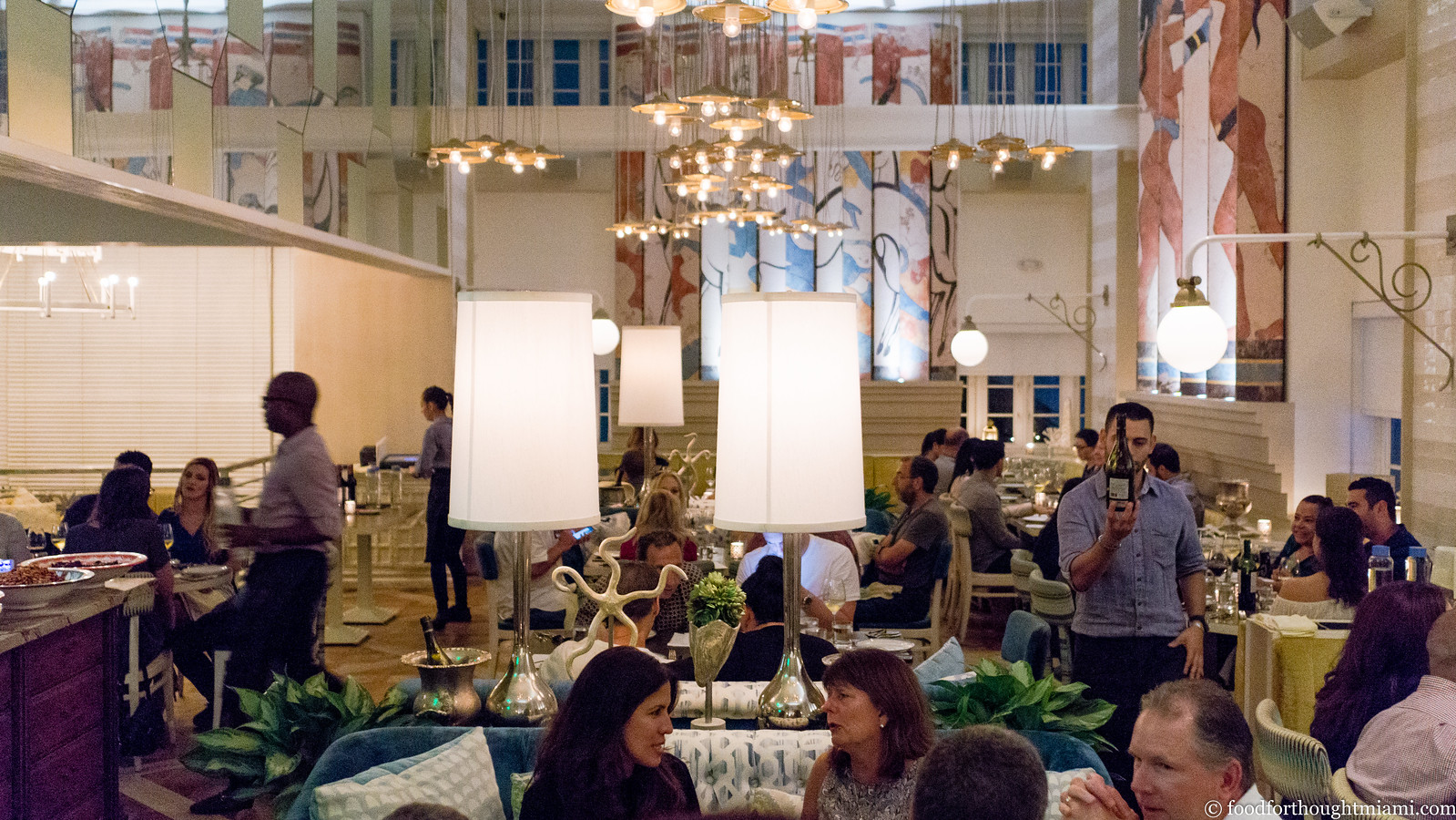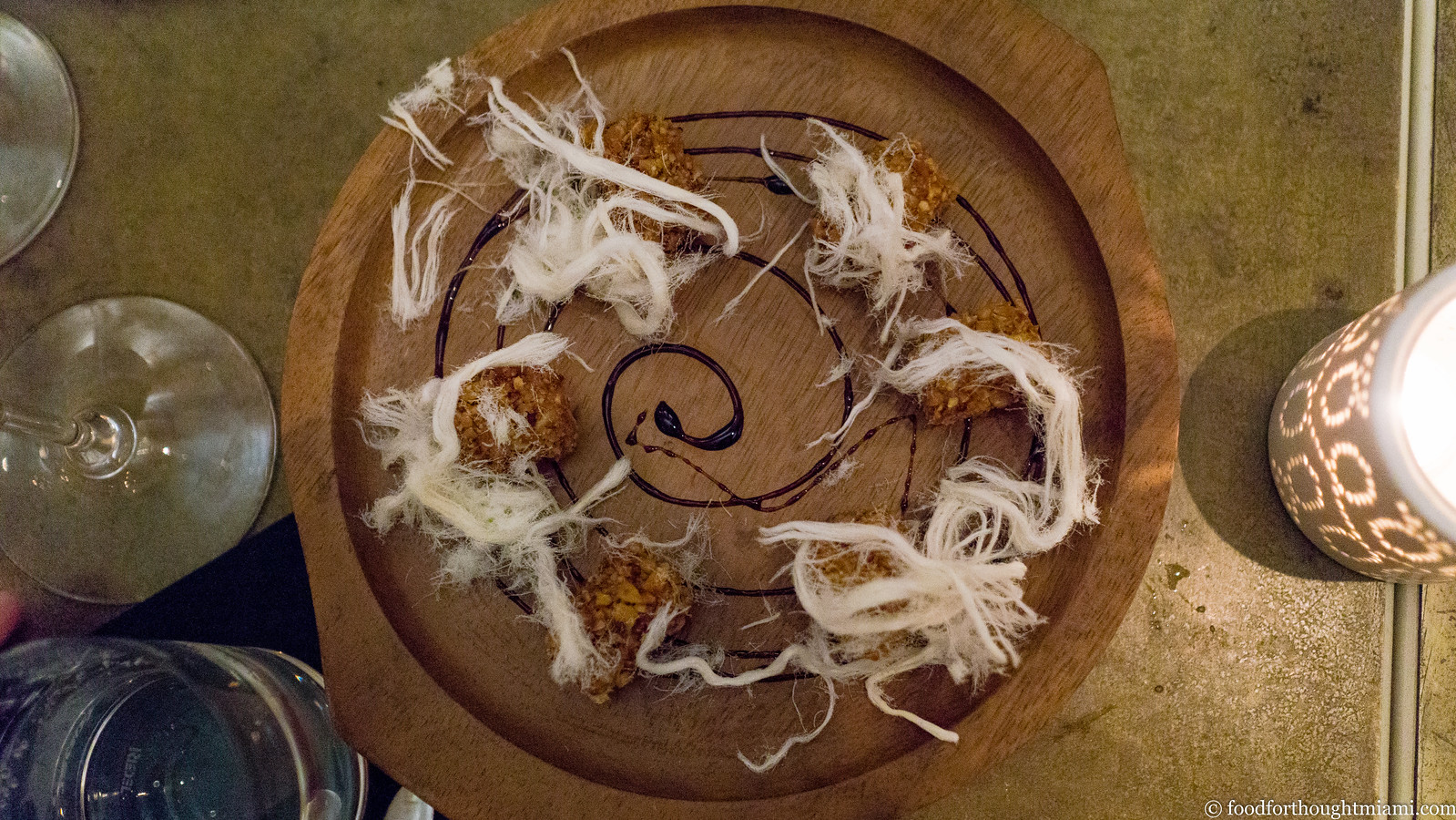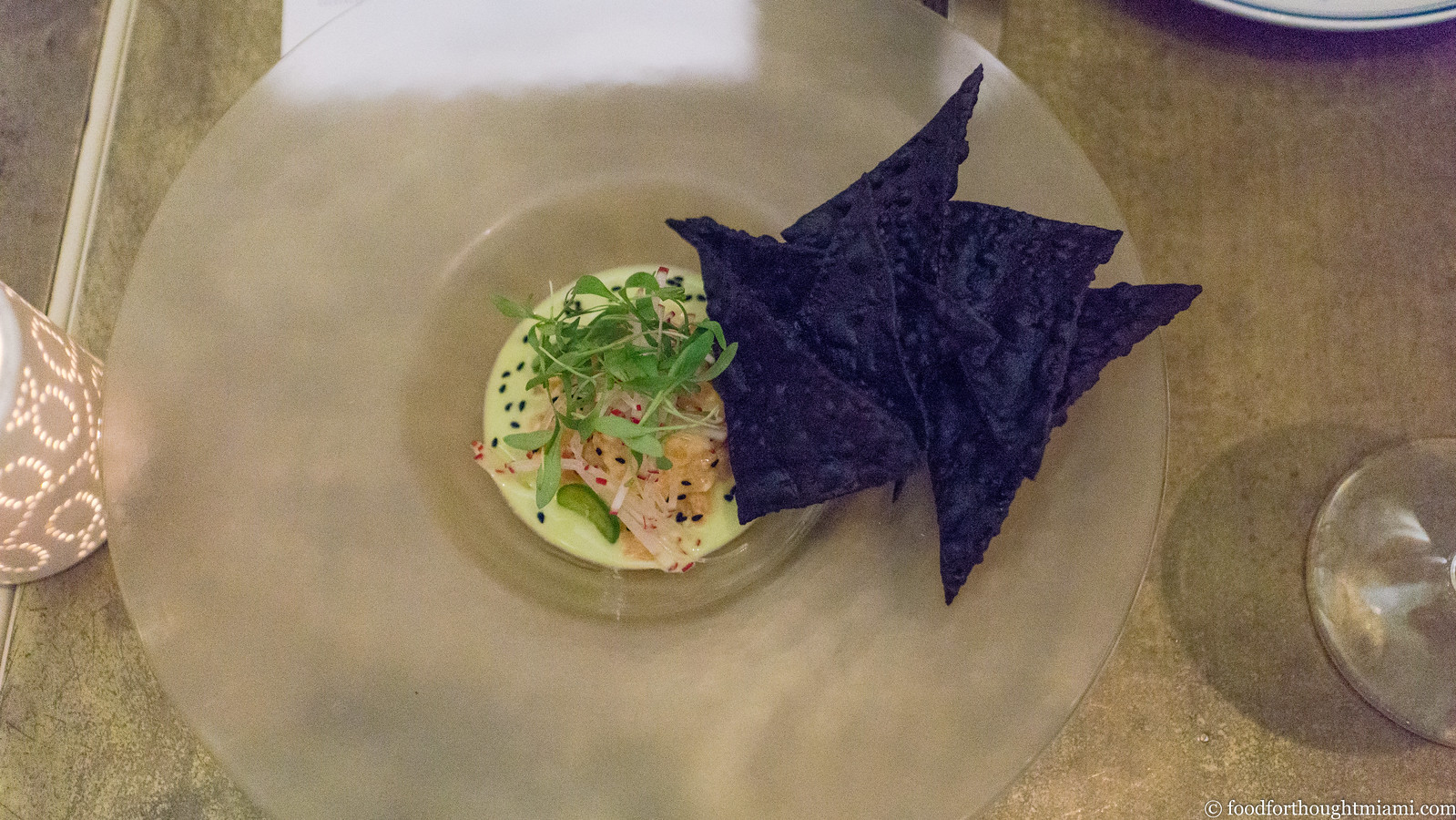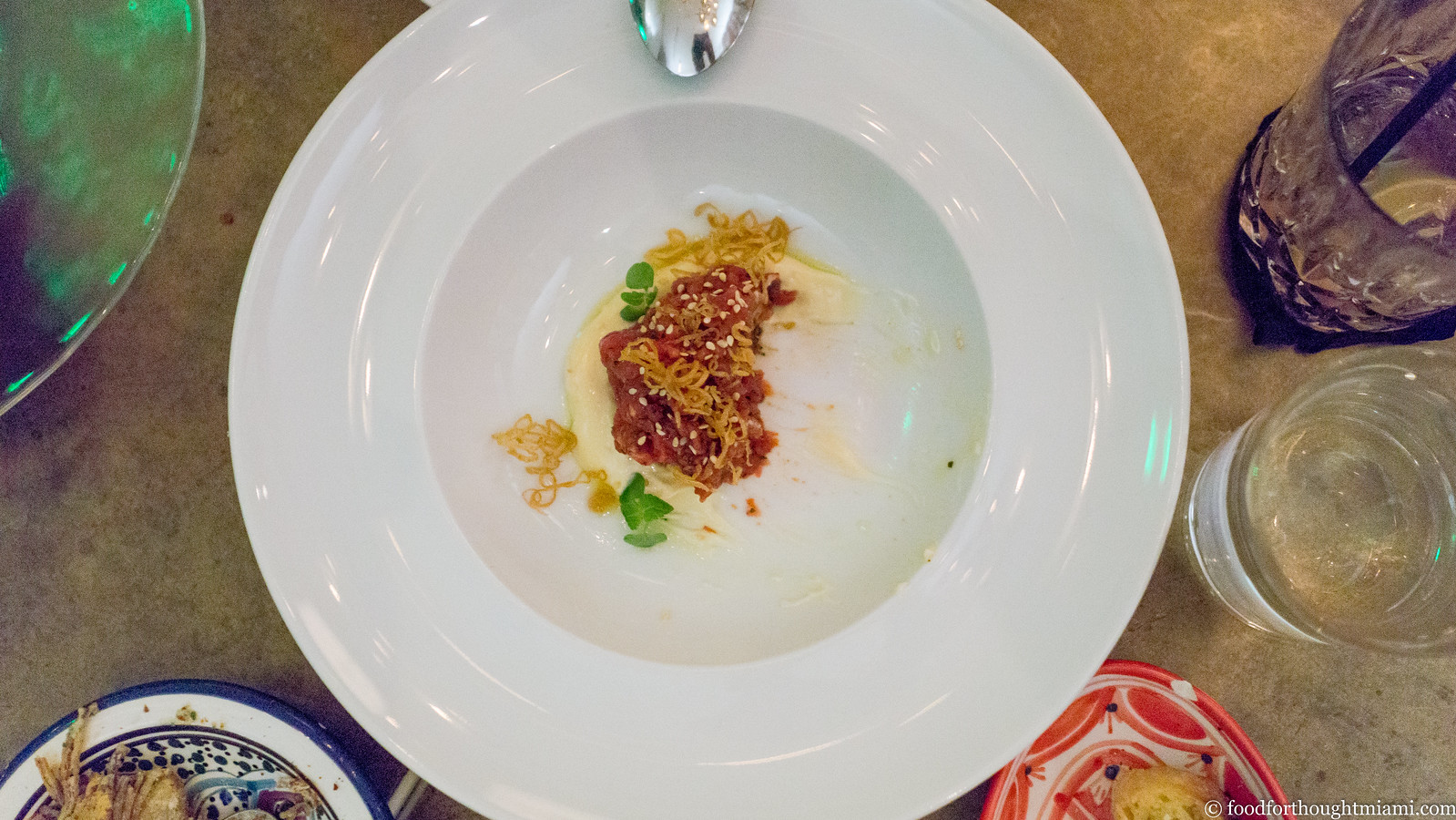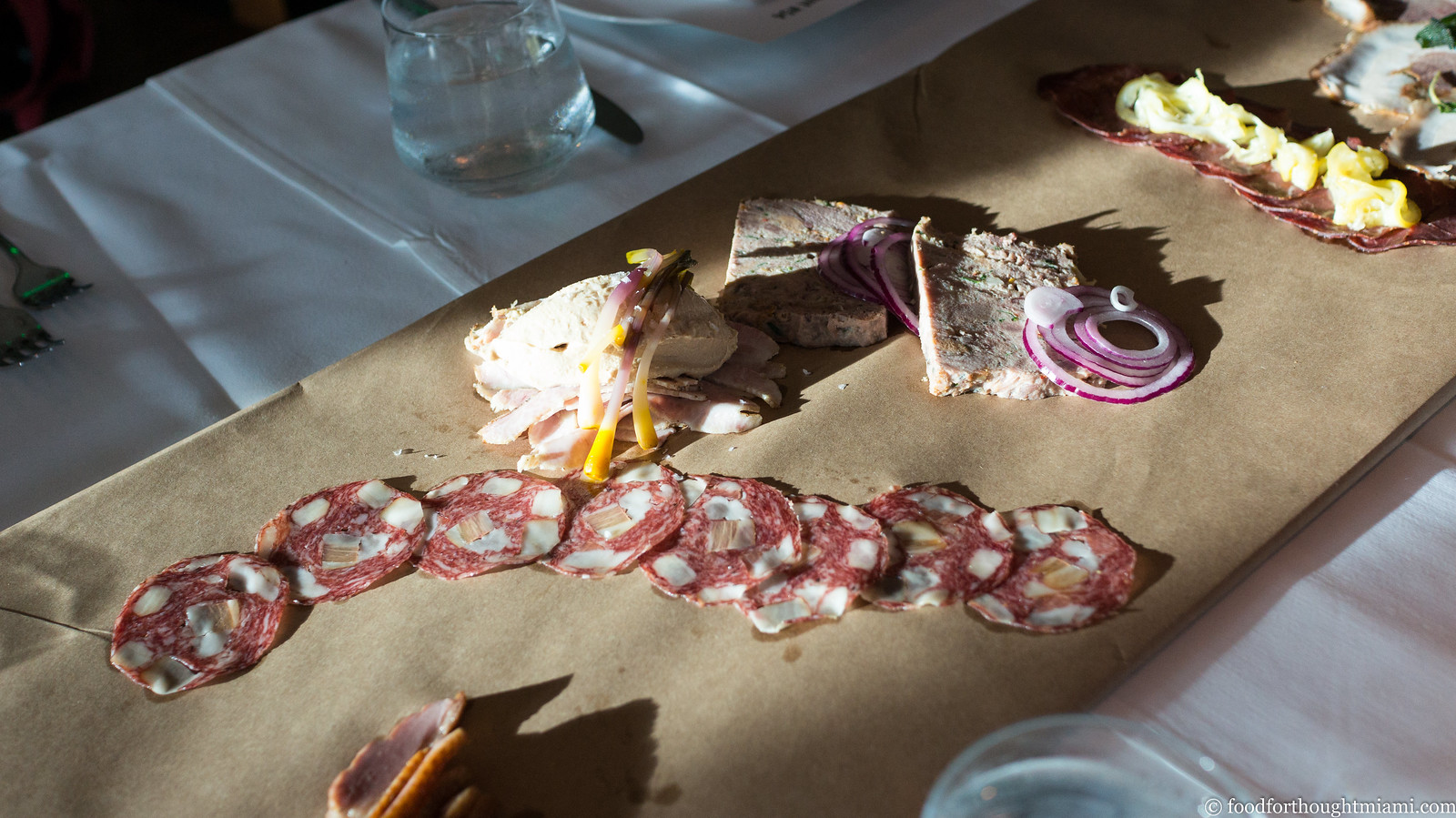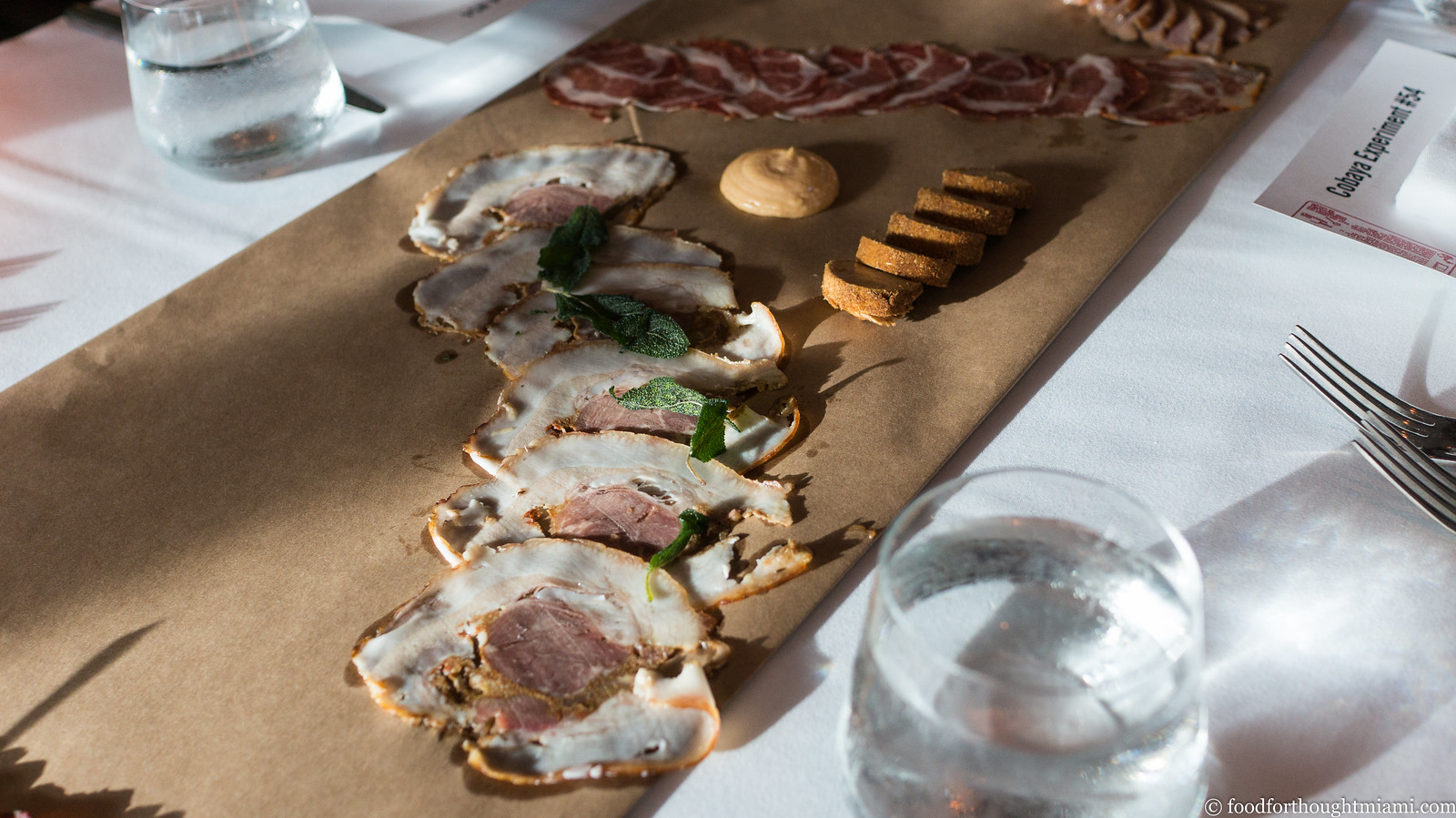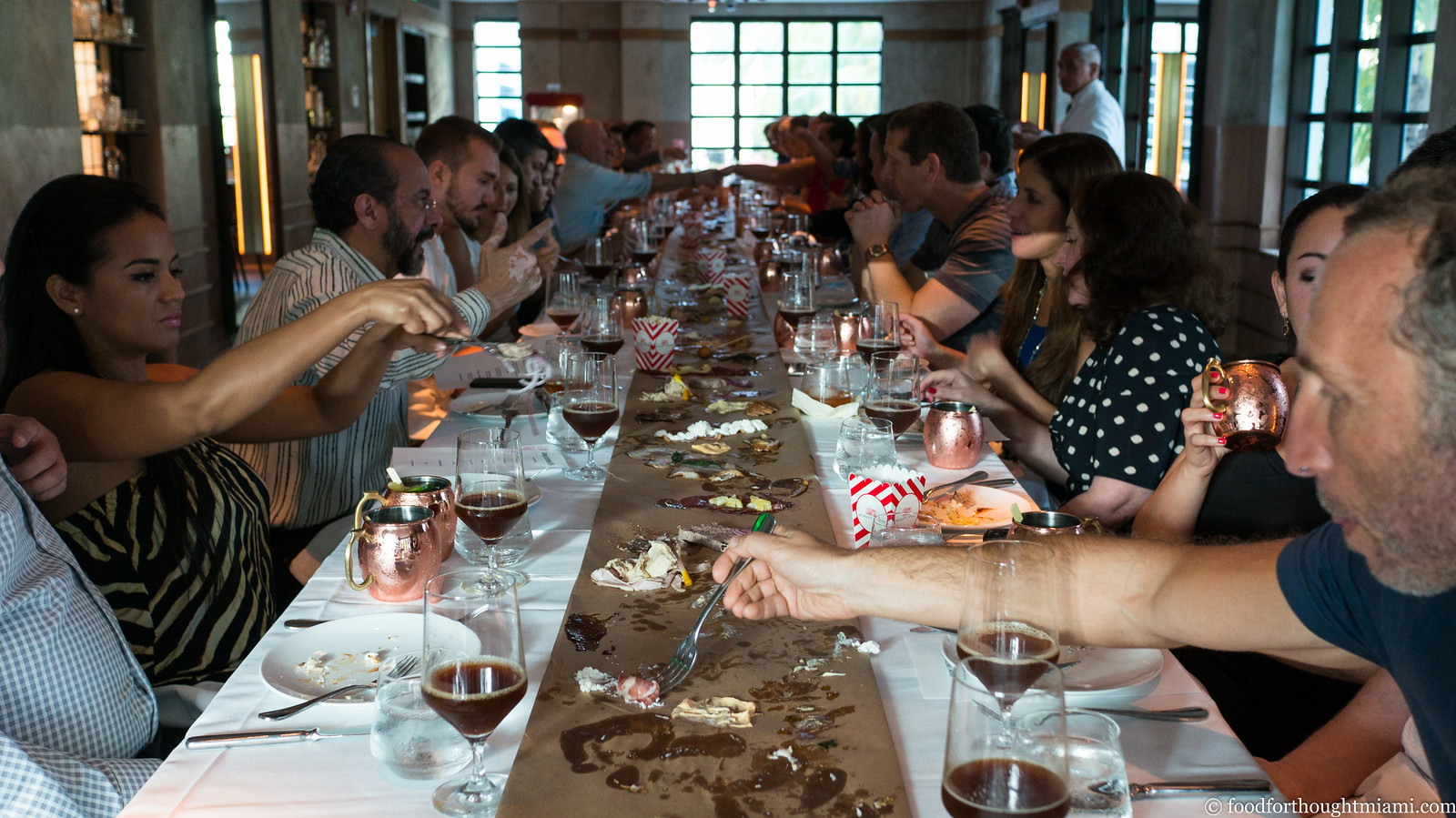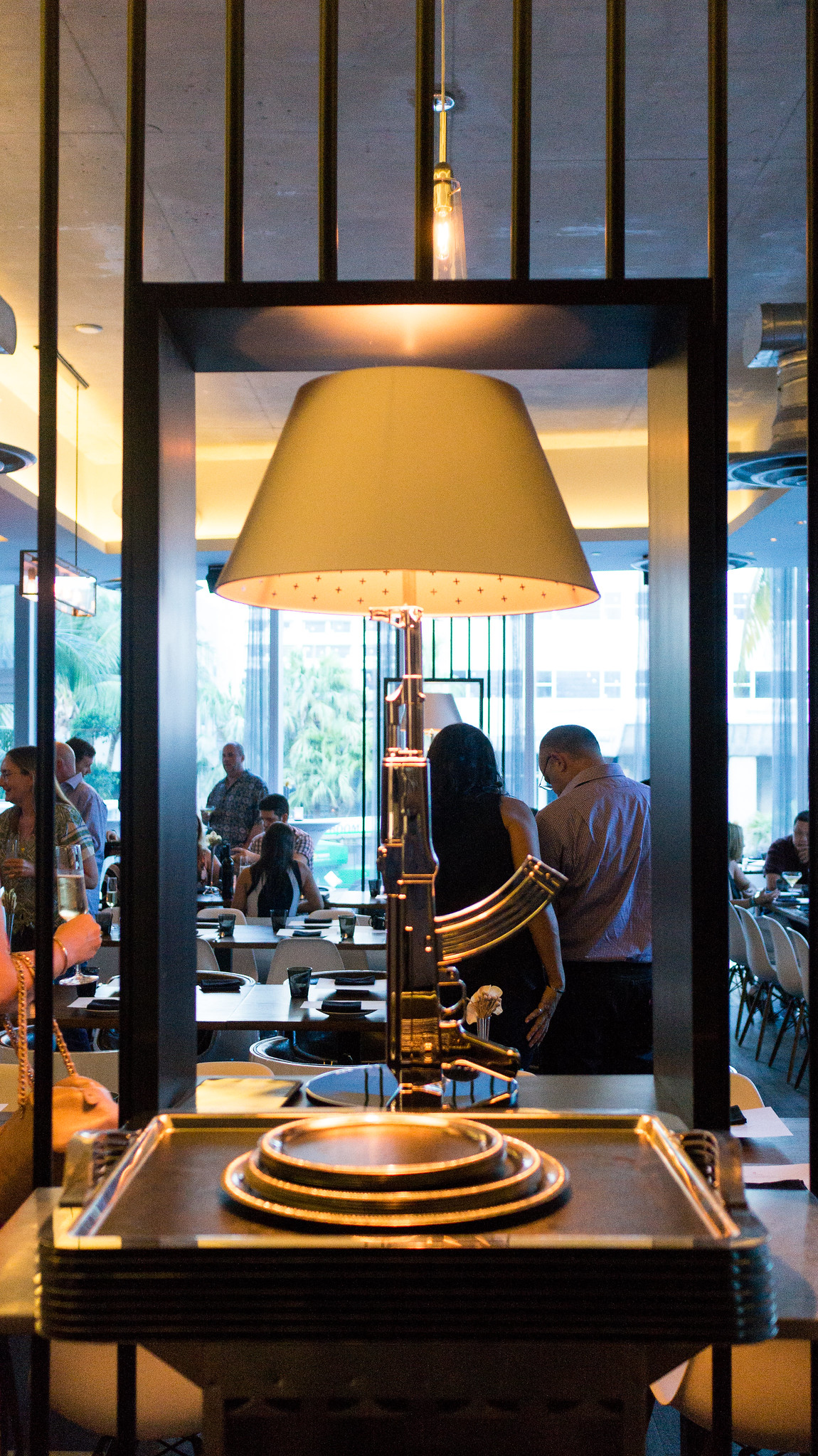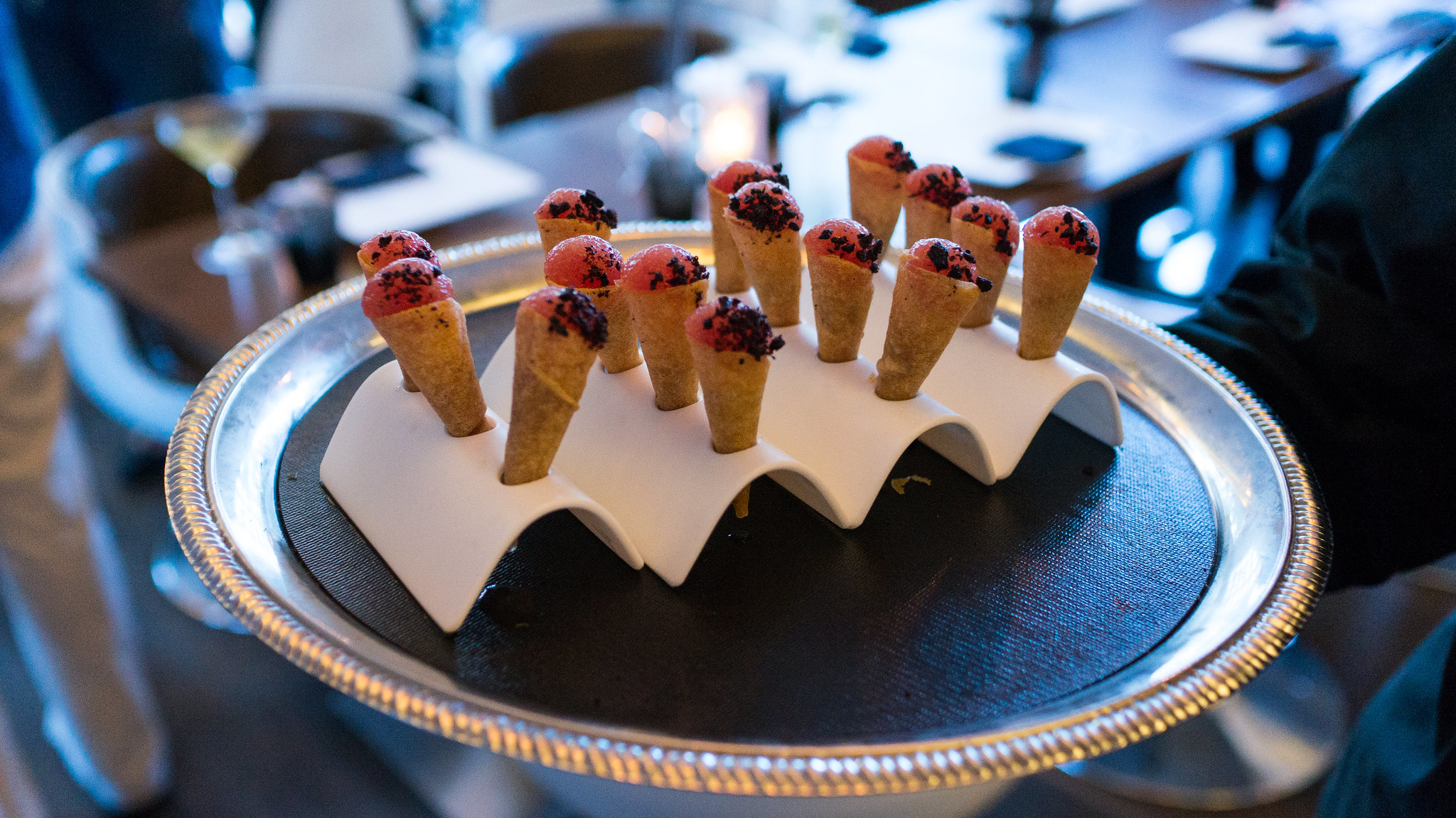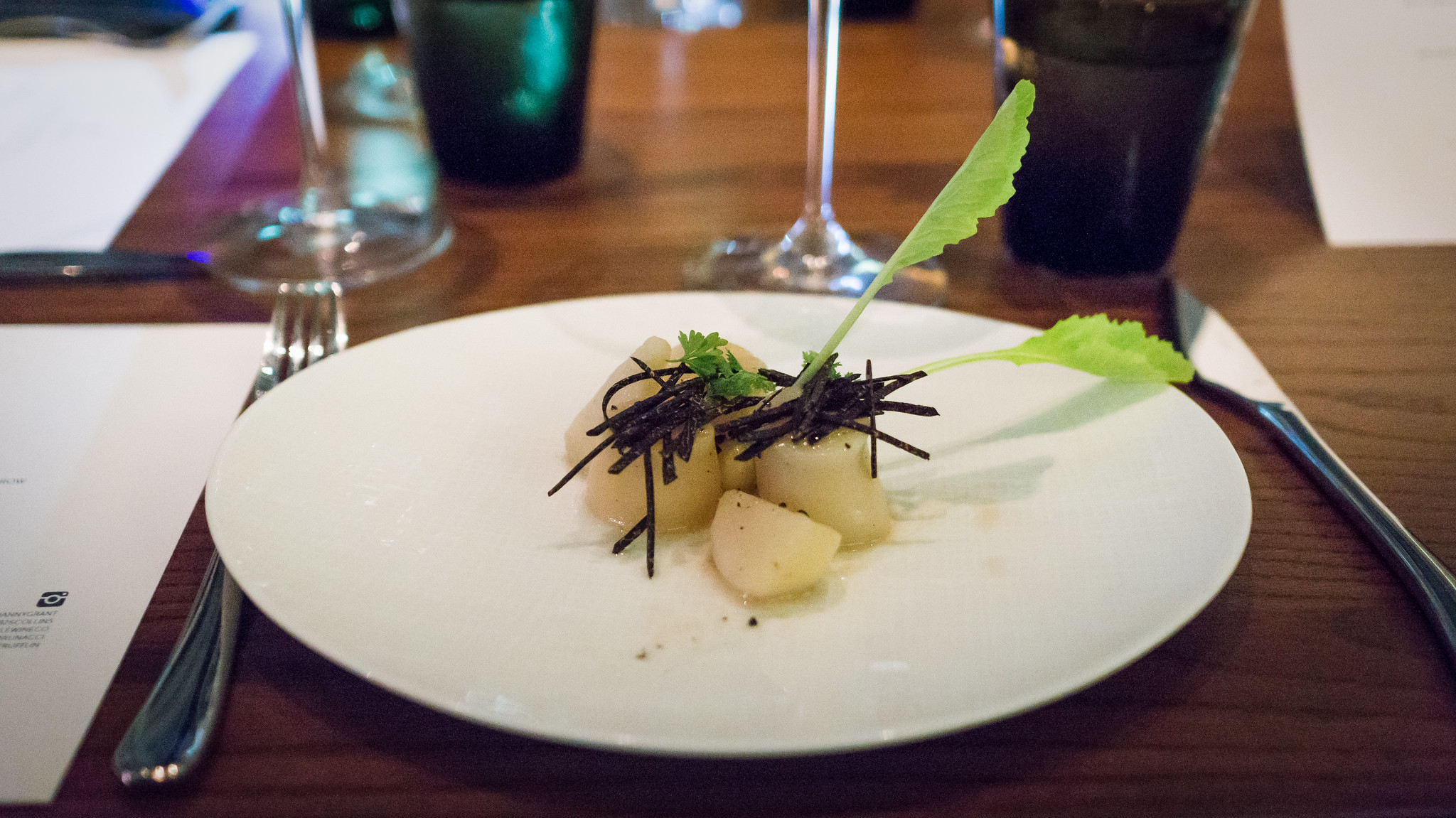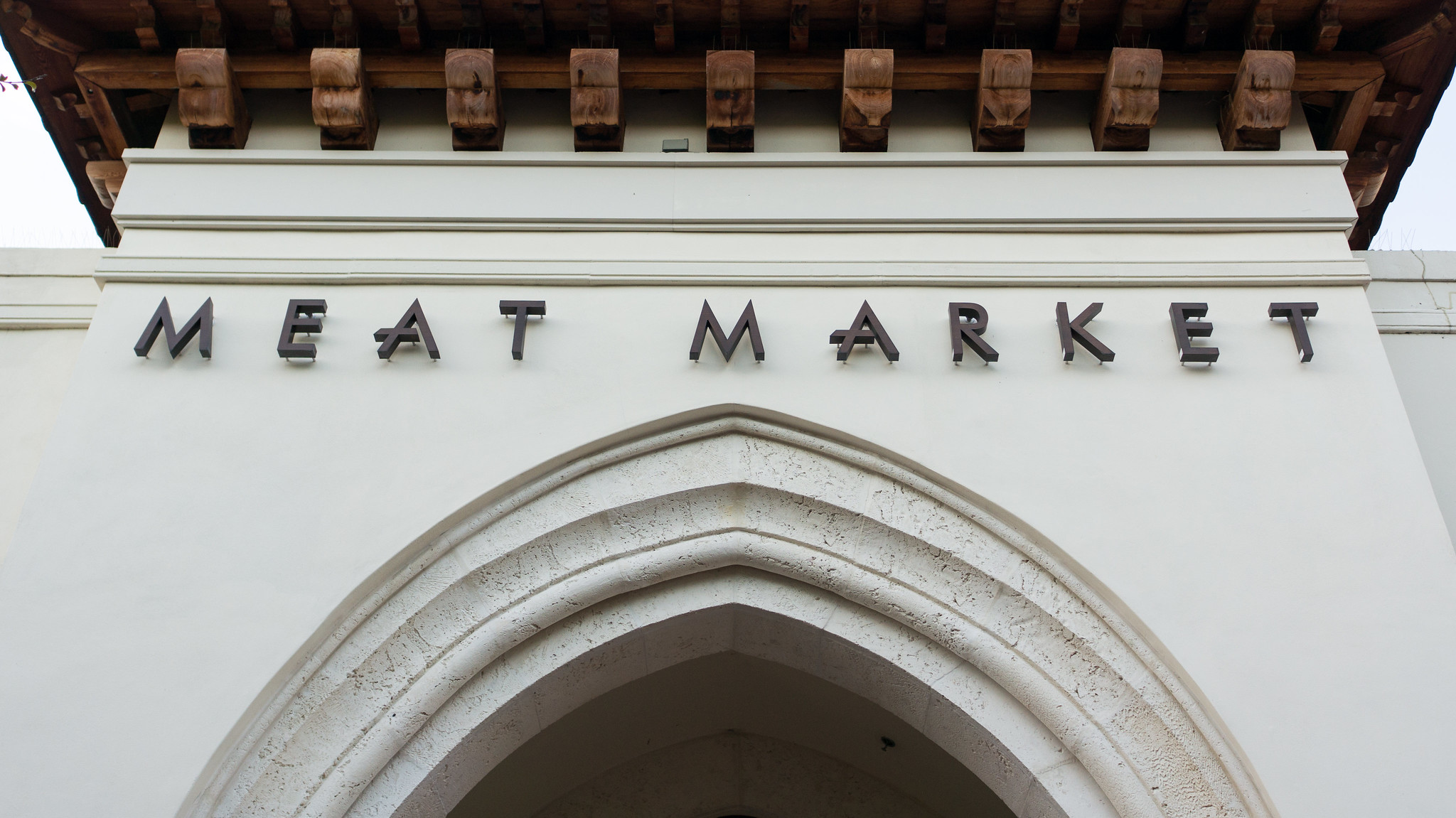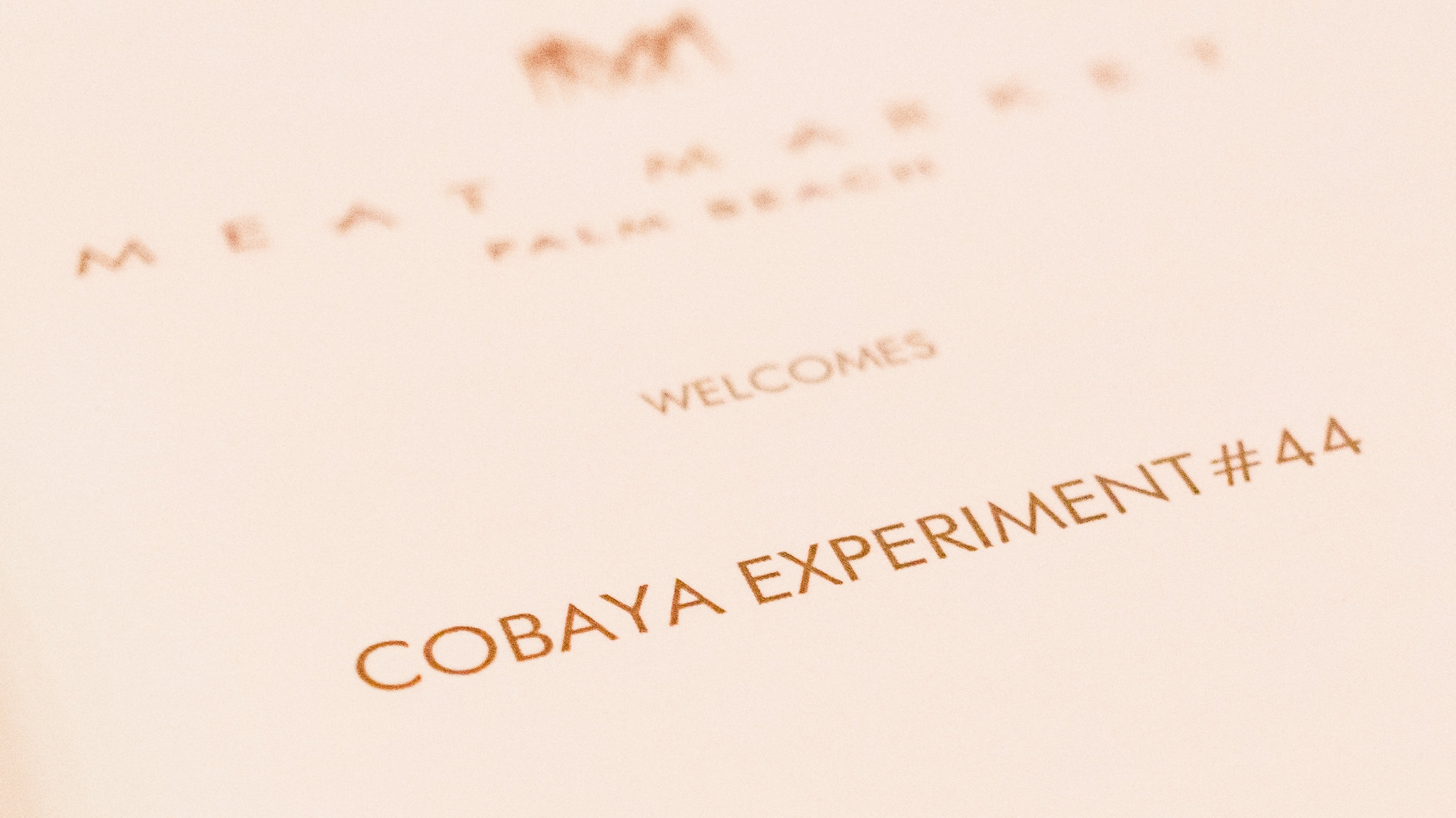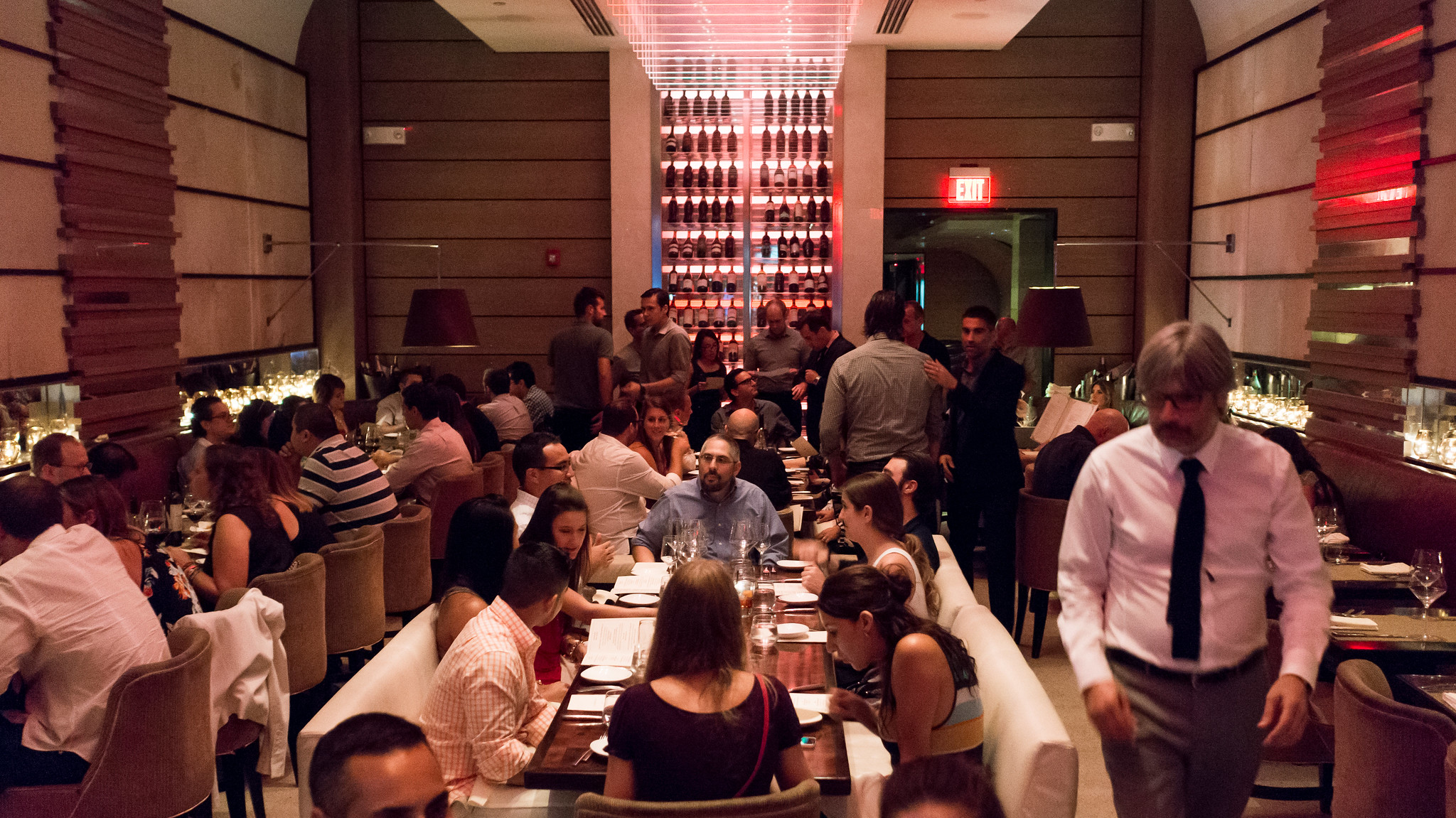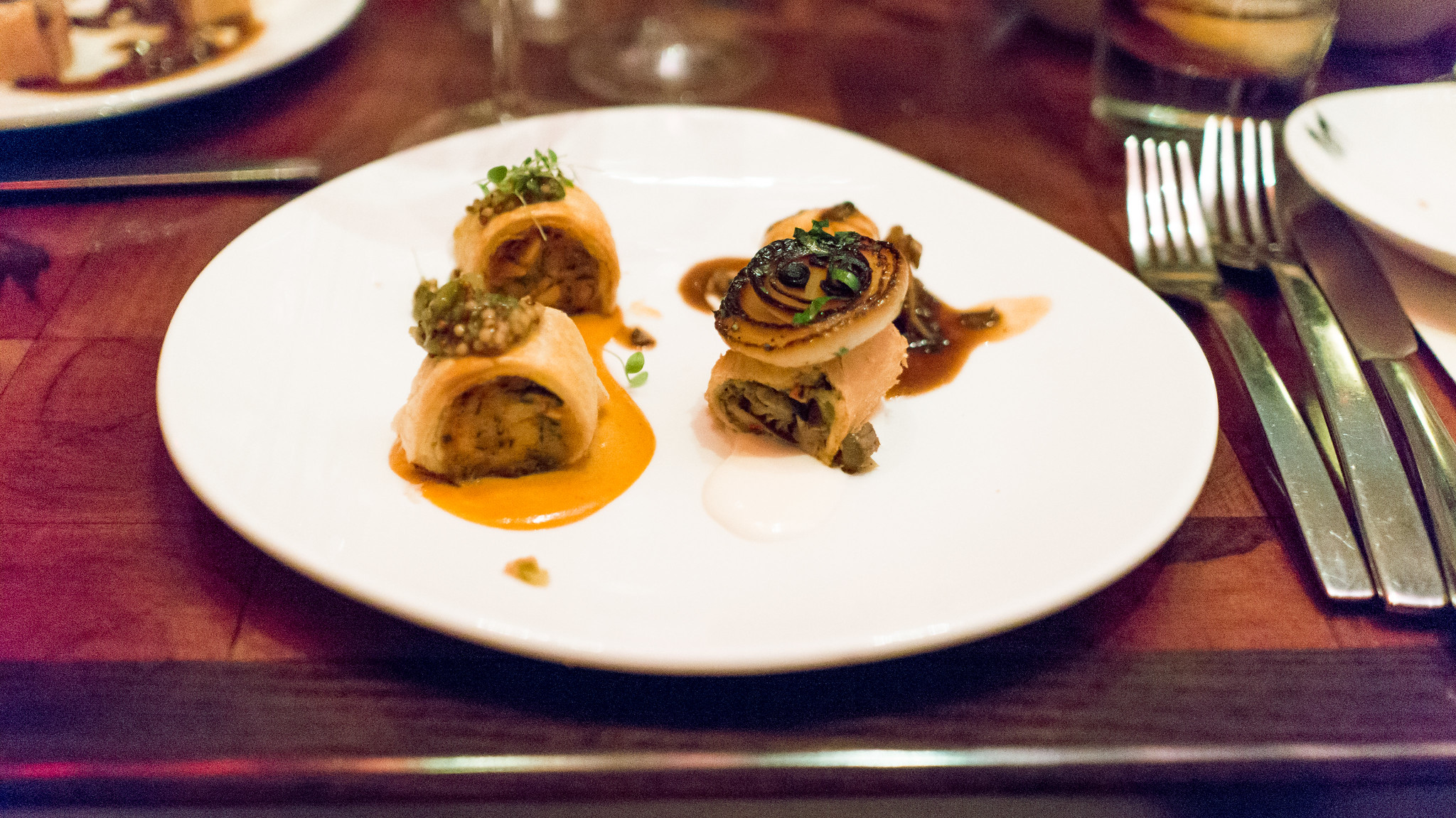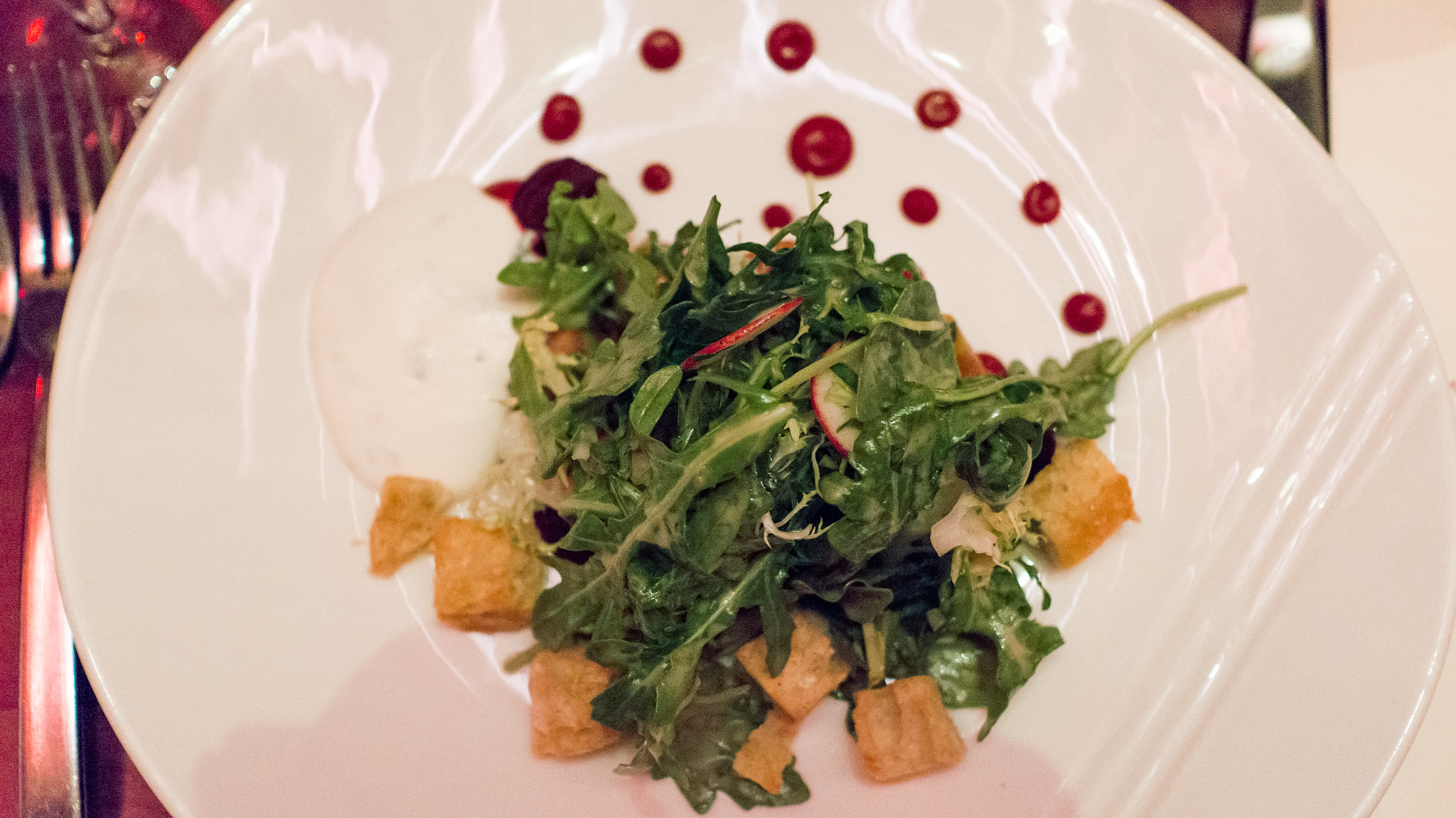Showing posts with label South Beach. Show all posts
Showing posts with label South Beach. Show all posts
Wednesday, April 4, 2018
Cobaya Upland with Justin Smillie
When I first heard that Upland was opening in Miami Beach, the place was something of an enigma to me. I thought of Justin Smillie as a New York City chef (one whose NYC restaurant, also named Upland, I'd never tried), but the menu felt like it came from the other coast. As it turns out, Upland is a town in San Bernardino County inland of Los Angeles where Smillie was born, and his cooking style is indeed very much inspired by the "California cuisine" idiom: seasonal, vegetable forward, casual in presentation but still precise in execution.
The South of Fifth spot, which Smillie opened with restaurateur Stephen Starr (whose Miami products also include Makoto and Le Zoo) has become one of my favorites among the latest crop of "Sixth Borough" restaurants in Miami. I love the dining room, designed by Roman & Williams, with its green leather banquettes and walls lined with backlit jars of preserved lemons. But even more, I love the food, whose superficial simplicity usually belies a sonorous depth of flavor.
We were eager to do a Cobaya dinner with him, and the interest was mutual, but since Smillie is not in South Florida regularly this was a challenging one to schedule. We finally lined up a date, and even though it was only a week after our last event, we jumped on the opportunity.
As always, our request to the chef was simple: do whatever you want, just don't do anything on your regular menu. Smillie's response was entirely off-menu, but also entirely in keeping with the spirit of his restaurant.[1] Here's what he made:
(You can see all my pictures in this Cobaya Upland with Chef Justin Smillie flickr set).
Smillie started things off with a salad – served family style – and my immediate reaction was, "It's not going to be as good as his little gem salad," a combination of perky gem lettuce, avocado, cucumber, and shaved ricotta salata in a walnut vinaigrette that hits all the right notes for me. I was wrong. This was every bit its equal. Here were all sorts of early spring things: tender spinach leaves, asparagus, fava beans, artichokes, frilly little mushrooms that were crispy like croutons. Crumbled cotija cheese added some creamy richness, a precisely balanced vinaigrette added structure and brightness.
Mrs. F thinks I hate salads. I don't. A good salad makes me very happy, and this was a very good salad.[2]
Spring is also the season for soft shell crabs, when they molt from their hard exoskeletons and basically the whole critter can be eaten. Smillie gave these a crispy new shell of flaked coconut, and served them with a hemp seed aioli and a bouquet of fresh soft herbs. There was a sneaky bit of nostalgia here which it took me a while to pinpoint: this was like a gussied up version of coconut shrimp!
Speaking of nostalgia – when was the last time you had mango salsa? When was the last time you actually saw mango salsa on a menu, even here in the erstwhile capital of Mango Salsaville? Smillie described this dish as "hot smoked tuna cheek, spicy mango," but let's call that "spicy mango" what it is: MANGO SALSA! And it was delicious! The smoked tuna cheek, like the Japanese izakaya staple hamachi kama (yellowtail collar), was somewhat fiddly and took some work to extract the good bits, but the reward was some of the fattiest, most unctuous, flavorful flesh on the fish. And yes, it tasted great with the sweet and heat of that "spicy mango," as well as the blistered shishito peppers and huge basil leaves draped on top.
If the Miami Heat can break out some neon pink and blue Miami Vice uniforms this year, it's only fitting we bring back mango salsa too.
(continued ...)
Monday, November 13, 2017
first thoughts: Stubborn Seed | Miami Beach
Summer in South Florida isn't good for much. Mangoes. Avocados. Royal poincianas. That's about it. It's the season of 90° heat with 90% humidity, hurricanes, and restaurant closures.[1] But we've made it through to the other side! The thermometer occasionally dips below 80°, most of the trees downed by Hurricane Irma have been cleared, and new restaurants are popping up left and right. Among them is Stubborn Seed, which opened in late September. It is the first of two new projects[2] from chef Jeremy Ford, who was last heading up the kitchen at Jean-Georges Vongerichten's Matador Room, though many more folks probably know him from his victory in Top Chef Season 13.
This is a much more intimate affair than his last gig. Ford has traded a big hotel restaurant for a corner spot in South Beach's quieter SoFi (South of Fifth) neighborhood, where about sixty seats are divided between a bar area with high-tops as you enter and a somewhat stark dining room in back, all buffed gray walls and dark wood tables.
(You can see all my pictures in this Stubborn Seed flickr set.)
The menu at Stubborn Seed is somewhat stark as well: it comprises fifteen items all told, which includes a "bread service" that was brought to our table without charge.[3] It's matched by a cocktail selection that is nearly the same size – in fact, the actual drinks menu is in the form of a newspaper which dwarfs the size of the food menu.
The bread service and the cocktails are a good way to start things off at Stubborn Seed. The bread is a puffy version of Colombian pan de bono, dusted with fennel pollen and coarse salt, and served with a dollop of an herb-flecked green garbanzo dip whose bright color matches its flavor. And you'll want to spend some time with these cocktails, because they're a production. The "Negroni a la Ford" is made with Del Maguey Vida Mezcal in place of the gin, plus Ancho Reyes, white creme de cacao, and Xocolatl Mole bitters, as well as a passionfruit marshmallow suspended across the glass which you can toast over a flaming sugar cube.[4] The "Silver Dollar Old Fashioned" is a D.I.Y. project which literally arrives on a silver platter, with a cut-glass decanter of rye, a dropper of house-made bitters, a shaker of simple syrup, and a big ice block in a glass. There's a lot of ungapatchka here, but you could skip the s'mores and the silver platters and they'd still be very good drinks.
It's possible you've heard this before, but dishes "are meant to be shared," and "come out of the kitchen as they're ready." We ordered several of the crudos and "snacks" (which collectively make up 2/3 of the short menu) and one larger dish to share; happily, rather than the confused multi-plate pile-up that often ensues, our meal was coursed out in a series of rounds that actually made sense. But pity the diner who just wants their own appetizer followed by an entree these days.[5]
When Ford was on Top Chef, I nicknamed him "Crudo Bro," because every dish he made was a crudo,[6] and because he is clearly a member of the Broheim Tribe.[7] So we had to try both iterations featured on the menu. The one pictured at top was a winner: meaty, fatty Hawaiian kajiki (blue marlin), paired with creamy buttermilk and spicy fermented chiles, kombu, ribbons of Asian pear, and dried sea grapes. It was great.
The other, featuring local snapper cured in JoJo tea, with slivers of heart of palm and clementine segments, awash in a green bath of sorrel and celery, was dominated by the cloying sweetness of the clementine. This dish needs something to perk it up other than the smoke from dry ice added to the bowl.[8]
This lavash cracker, spread with chicken liver mousse and dotted with smoked chili jam, was just delicious – crunchy, creamy, rich, spicy, sweet. Shared between two people, it makes for only a couple bites, and may well leave you pining for another.[9]
(continued ...)
Wednesday, April 26, 2017
Cobaya Olla with Chef Scott Linquist
Mexican cuisine is one of several that gets saddled with the "soft bigotry of low expectations." The common perception is that it's all chips and salsa and guacamole, tacos and burritos and fajitas, with maybe some tequila shots, mariachi bands and sombreros mixed in for good measure. In fact, it's an incredibly complex and varied cuisine, which is finally starting to get the attention it deserves in the U.S.: witness the success of Enrique Olvera's Cosme in New York, or Alex Stupak's Empellon, or places like Taco Maria and Broken Spanish in L.A., or Californios and Cala in San Francisco, or Rick Bayless' restaurant empire, plus new Chicago places like Dos Urban Cantina and Mi Tocaya. I could keep going; but instead, let me bring this back home.
Because someone is trying to help Miami catch up. At Olla, Chef Scott Linquist's new restaurant on the west end of Lincoln Road, you'll find a menu that goes well beyond the customary tropes, ambitious both in its pursuit of the authentic flavors of Mexico and in finding modern ways of presenting them. My first visit to was in December, only a week after they'd opened, and I was pretty excited by what I found. Not much later, we started to work on putting together a Cobaya dinner, which came to fruition last week.
(You can see all my pictures from the dinner in this Cobaya Olla with Chef Scott Linquist flickr set).
Everyone was welcomed with a house cocktail – a variation on the flavors of a Moscow Mule, which they dubbed the "Oaxacan Burro," featuring Alipus mezcal, a ginger and epazote shrub, a slug of ginger beer and a squeeze of lime. This was prelude to a mezcal sampling courtesy of XXI Wine and Spirits, a distributor for Alipus, which poured three different "single village" offerings. I'm becoming a real fan of mezcal, which is almost exclusively a craft, small-production product, and which can show a fascinating variety of styles and flavors – some with a clean, almost sake-like purity, others floral, or fruity, or grassy, or smoky, or all of the above.
Once our group of fifty was seated (we took over the restaurant for the night), dinner started with a round of bocadillos, or snacks.
Yes, chips and salsa. But not just any garden variety salsa: four different salsas, starting with a basic salsa fresca, and also including a fresh, raw salsa verde (with some bright, fragrant mint in addition to the usual cilantro), a deeper-flavored, charred tomatillo and habañero salsa verde, and a hearty, red brick hued version with pasilla Oaxaca chiles[1] and roasted pineapple. Plus guacamole, because yes, everyone loves guacamole.
(continued ...)
Tuesday, December 6, 2016
first thoughts: Olla | Miami Beach
I have always had a particularly soft spot in my heart for good Mexican restaurants. I'm not talking about taquerias, though I have another very soft spot for those too. Rather, I mean higher end restaurants that treat Mexican cuisine with reverence and genuine curiosity rather than an excuse to blanket everything in melted cheese and decorate with piñatas and sombreros. I don't remember much about my long-ago college years, but I fondly recall such a place on the outskirts of Atlanta called Mexico City Gourmet.[1] Even after a couple decades, I can still taste in my mind the outstanding duck fajitas they made at a spot called Las Puertas on Giralda Avenue in Coral Gables, and the gorgeous chiles en nogada that would occasionally turn up as a special.
So when I saw a preview menu for Olla, a new restaurant which opened last week from chef Scott Linquist (who also runs Wynwood's Coyo Taco), I was pretty excited. Far from the garden variety selection of tacos, burritos and enchiladas, here's something creative and different that explores the variety of flavors of Mexico: chapulines and huitlacoche and menudo, a kaleidoscope of chiles, four different kinds of moles. Yes, I could really get into this.
We popped in at noon this past Sunday, just as they were opening the doors, to try it out for a pre-Art Basel brunch.[2] (You can see all my pictures in this Olla Miami - South Beach flickr set).
The menu leads off with several "tarros," or jars, with a variety of different layered compositions inside. You hear so often these days about dishes "designed for sharing," when they are really nothing of the sort – either a few measly bites, invariably in a number not divisible by the number of diners at the table, or something so preciously constructed as to be impossible to split. These tarros are truly designed for sharing, and do it well.
The "remolacha" has cubes of garnet and golden beets nestled over a walnut cream, topped with jewel-like pomegranate seeds and toasted walnuts, served with spears of pale endive. Scoop some into an endive spear; crunch; repeat. I liked how the combination of walnut and pomegranate echoed the traditional toppings for that chiles en nogada dish ingrained in my memory so many years ago.
Maybe even better was the "ahumado," with hot smoked salmon, chunks of boiled egg, crema, a dark green poblano-tomatillo salsa, and a dollop of salmon roe, with soft toasted bolillo bread soldiers for dipping.
Another section of the menu is given over to masa in various forms (supplied, I believe via masa maestro Steve Santana of Taquiza). We tried the gordita, similar to a Colombian arepa, split and stuffed with duck carnitas rubbed with pasilla Oaxaca chiles, and sauced with an orange-kumquat marmelada which ran a little too sweet for me. There's also a sweetbread sope, a skirt steak huarache, and a chicken tamal with mole coloradito.
"Olla" means "pot" in Spanish, and another section of the menu is given over to more than a half-dozen different dishes all served up in this fashion. Some are stews, like this rich, sticky menudo chock full of tripe, pork, and hominy in a red chile broth, topped with a fried egg and a garnish of chicharrones. There's also frijoles charros – cowboy beans – enriched with pork belly and cheek. There are also vegetables dishes, like huitlacoche (corn fungus) with wild mushrooms, toasted garlic, arbol chiles, queso fresco and epazote; and esquite, seared corn with the typical Mexican accompaniments of morita chile, mayo, cotija cheese and lime.
(continued ...)
Tuesday, November 8, 2016
Cobaya Byblos with Chef Stuart Cameron
I've been meaning for some time to write about Byblos, a new-ish restaurant on South Beach in the old Shorecrest Hotel. A more expansive review will be forthcoming at some point, but the short version is this: despite my general aversion to South Beach hotel restaurants, especially those by big out-of-town restaurant groups, I think Byblos is putting out really flavorful, contemporary Middle Eastern food in a beautiful space and providing excellent service. Even shorter: I really like it.
In the meantime, here's a recap of the Cobaya dinner we held there last week with Chef Stuart Cameron, who came down from Toronto to cook for fifty of us guinea pigs who took over the upstairs dining room. I thought he and his crew did a very good job of going off-menu while still capturing the spirit of the place.
(You can see all my pictures in this Cobaya Byblos wtih Chef Stuart Cameron flickr set).
For a first bite, foie gras bonbons, rolled in nuts, drizzled with rose jam, and wrapped loosely in pashmak, a Persian sesame and sugar flavored cotton candy. For another little snack, a bowl of crisp-fried slivered baby artichokes, paired with an herb-infused tahini tarator sauce.
A round of raw dishes inspired by Lebanese kibbeh nayeh followed. The salmon nayeh featured diced pink salmon swimming in a jalapeño dressing, the spice level amped up even further by a green schug (a Yemenite chile paste). Even better was the grass-fed steak tartare, enriched with a silky argan oil aioli, warmed with Fresno chile peppers, brightened with dried mint, and given some textural contrast with a shower of crispy shallots. It was excellent. I like that Cameron does not shy away from spicy and bold flavors, while still keeping them in balance.
(continued ...)
Monday, March 14, 2016
best thing i ate last week: razor clams and rice at Bazi "kaiseki" dinner
I was surprised when I heard that pasta master Michael Pirolo of Macchialina was opening an Asian-inspired restaurant – Bazi. Pirolo's culinary upbringing is Italian through and through. He was raised in Italy, went to culinary school in Torino, and did apprenticeships in Bologna and the Piemonte. The first kitchen he ran as chef de cuisine was Scott Conant's Scarpetta, then he went out on his own with Macchialina (originally opened with the Pubbelly boys, but from whom he split a few years ago).
I didn't see how an Asian restaurant fit with that resume and, to be very candid, figured the motivation was money rather than passion. My theory was thrown into doubt, though, when Bazi recently announced it would start doing a special "kaiseki" style dinner on Wednesday nights for up to eight people at the downstairs bar. Not that $150 per person is exactly giving food away, but considering it's for a ten-course dinner inclusive of drink pairings, tax and tip, it doesn't seem like much of a money-maker either.[1] This is the kind of thing a chef does because they really want to, and maybe because they're a little crazy.
Let's not dwell too long on how much this truly resembles a traditional Japanese kaiseki dinner (short answer: not too much).[2] Instead, let's talk about the best thing I ate last week: the clams and rice dish Pirolo served as one of the courses.
(You can see all my pictures in this Bazi Kaiseki Dinner flickr set).
In this one dish, Pirolo ties together his Italian background and his Japanese ambitions. Diced razor clams are combined with chewy but tender viaolone nano rice, all served in the clam's shell. The rice is prepared in classic "all'onda" fashion, and bound with the clams by an uni vinaigrette which further highlights the flavors of the sea. A shower of fresh lemon balm adds a bright, herbaceous, citrusy note. It's a beautiful dish.
It was a close call between this, the chicken wing stuffed with five-spiced foie gras torchon, the black cod stuffed with Key West shrimp and Alaskan king crab with a nasturtium and avocado purée, and the roasted squab served with a coconut and ginger rice fritter. If that many dishes were in the mix, that's the sign of a pretty good meal. If you're interested, maybe check it out yourself this coming Wednesday.
Bazi
1200 Collins Avenue, Miami Beach, Florida
305.695.0101
[1] Full disclosure: Chowfather and I were guests of the house for this first of their Kaiseki Dinner Series. Had I been spending my own hard-earned dollars, however, I'd still have felt this was a pretty good value. Ten courses, several featuring at least some small doses of luxury ingredients like osetra caviar, uni and foie gras. A pairing with each course by Will Rivas, the talented beverage director of Bazi and Macchialina, including cocktails, sakes (some fruit-infused in-house), smartly selected wines, a rare Japanese beer, and a couple JoJo teas. With tax and tip included. You can spend $150 on a meal in Miami and do far worse.
[2] Longer answer? To my admittedly extremely limited knowledge, most of which is derived from the gorgeous book "Kaiseki" by Yoshihiro Murata (of Kikunoi restaurant) and a couple meals in Japan, there are a few key components to kaiseki. One is the procession of courses, which typically follows a certain pattern though there is some room for variation. Another is the importance of seasonality, with dishes and presentations that attempt to capture a particular moment in time (and consequently are often locally sourced as well). Finally, and linked indelibly to the seasonality component, is the focus on the ingredients themselves; presentations and plating can be rather ornate, but the dishes themselves are often quite elemental – not so much austere as serene, if that makes any sense.
Pirolo's menu paid some heed to the traditional kaiseki progression, without being mindlessly obedient to it. He started with "sakizuke," effectively an amuse-bouche, followed by "hassun," typically an assortment of several different seasonal items, then a sashimi course. Where there are usually then a series of simmered dishes and soups, often followed by a grilled fish, Pirolo took a detour through a series of dishes that didn't really have much traditional antecedent. But whatever – they were some of the best courses of the night. I did miss one of my favorite parts of the typical progression: a rice dish, typically served with pickles and soup, as the final savory item before dessert.
But what I felt was missing more than the progression was the seasonal, local element. There were lots of great dishes; but the ingredients were from literally all over the map, not much of it local, and not seemingly connected much to the season. Perhaps on a related note, too many dishes seemed to be more about the preparations than the ingredients themselves. For instance, with three fish used in the sashimi course, none were local and none were actually served raw: the arctic char was cured, the escolar was marinated in koji, the eel was grilled. This was also probably my least favorite course of the evening; while I have huge respect for Pirolo bringing in live eels and tackling the task of butchering and preparing them from scratch, I'm not convinced the end result is better – or more to the point, more in the spirit of "kaiseki" – than a simple preparation of pristine, fresh local fish.
Personally, I'd love to see a menu that's more about the ingredients, and less about what's been done with them. In this sense, I think Chef Kevin Cory's omakase dinners at Naoe – though he doesn't call them "kaiseki" – are actually much closer to that spirit. And if Pirolo called these "omakase" dinners rather than "kaiseki," I could spend a lot less time spinning wheels in my own head over whether that term really makes any sense here, and instead just focus on the food, which is what I'm really trying to do in this post, other than in this overlong footnote.
[2] Longer answer? To my admittedly extremely limited knowledge, most of which is derived from the gorgeous book "Kaiseki" by Yoshihiro Murata (of Kikunoi restaurant) and a couple meals in Japan, there are a few key components to kaiseki. One is the procession of courses, which typically follows a certain pattern though there is some room for variation. Another is the importance of seasonality, with dishes and presentations that attempt to capture a particular moment in time (and consequently are often locally sourced as well). Finally, and linked indelibly to the seasonality component, is the focus on the ingredients themselves; presentations and plating can be rather ornate, but the dishes themselves are often quite elemental – not so much austere as serene, if that makes any sense.
Pirolo's menu paid some heed to the traditional kaiseki progression, without being mindlessly obedient to it. He started with "sakizuke," effectively an amuse-bouche, followed by "hassun," typically an assortment of several different seasonal items, then a sashimi course. Where there are usually then a series of simmered dishes and soups, often followed by a grilled fish, Pirolo took a detour through a series of dishes that didn't really have much traditional antecedent. But whatever – they were some of the best courses of the night. I did miss one of my favorite parts of the typical progression: a rice dish, typically served with pickles and soup, as the final savory item before dessert.
But what I felt was missing more than the progression was the seasonal, local element. There were lots of great dishes; but the ingredients were from literally all over the map, not much of it local, and not seemingly connected much to the season. Perhaps on a related note, too many dishes seemed to be more about the preparations than the ingredients themselves. For instance, with three fish used in the sashimi course, none were local and none were actually served raw: the arctic char was cured, the escolar was marinated in koji, the eel was grilled. This was also probably my least favorite course of the evening; while I have huge respect for Pirolo bringing in live eels and tackling the task of butchering and preparing them from scratch, I'm not convinced the end result is better – or more to the point, more in the spirit of "kaiseki" – than a simple preparation of pristine, fresh local fish.
Personally, I'd love to see a menu that's more about the ingredients, and less about what's been done with them. In this sense, I think Chef Kevin Cory's omakase dinners at Naoe – though he doesn't call them "kaiseki" – are actually much closer to that spirit. And if Pirolo called these "omakase" dinners rather than "kaiseki," I could spend a lot less time spinning wheels in my own head over whether that term really makes any sense here, and instead just focus on the food, which is what I'm really trying to do in this post, other than in this overlong footnote.
Monday, July 6, 2015
best thing i ate last week: charcuterie at Quality Meats
It wasn't any one thing in particular (though they were all pretty excellent); it was the sheer joyous abundance and variety of the charcuterie spread that Chef Patrick Rebholz laid out for his Cobaya dinner at Quality Meats last Tuesday.
There was a smoked soppressata, topped with a cornbread cream. There was suckling pig coppa di testa, topped with fried sage leaves. Cured foie gras torchon, rolled in malted barley and a mango gastrique. A hearty pork headcheese with rounds of slivered onion. Hickory smoked duck bacon. Coppa, topped with aerated mozzarella. Calf liver mousse with pickled ramps. Merguez "prosciutto" topped with preserved lemon. Pork jowl corn dogs with tabasco mayo. Popcorn drizzled with melted dry-aged beef fat. All of it made in-house, all laid out up and down a roll of butcher's paper stretched along a forty foot table as we entered the room.
It was the best thing I ate last week. (You can read more about the dinner here).
There was a smoked soppressata, topped with a cornbread cream. There was suckling pig coppa di testa, topped with fried sage leaves. Cured foie gras torchon, rolled in malted barley and a mango gastrique. A hearty pork headcheese with rounds of slivered onion. Hickory smoked duck bacon. Coppa, topped with aerated mozzarella. Calf liver mousse with pickled ramps. Merguez "prosciutto" topped with preserved lemon. Pork jowl corn dogs with tabasco mayo. Popcorn drizzled with melted dry-aged beef fat. All of it made in-house, all laid out up and down a roll of butcher's paper stretched along a forty foot table as we entered the room.
It was the best thing I ate last week. (You can read more about the dinner here).
Friday, July 3, 2015
Quality Cobaya with Chef Patrick Rebholz
The scent – well, let's be more blunt – ripe, animal funk of cured meats as we entered the room was a good sign. It soon became apparent from whence it came: a spread of charcuterie laid on top of butcher paper that stretched all the way down a table set for forty guests.
We were in a private second-floor room in the old Bancroft Hotel on South Beach, a beautiful property whose Art Deco features have been pretty respectfully preserved. It's now the home of the Miami outpost of Quality Meats, a New York restaurant with some historical legacy itself: its owners opened the original Smith & Wollensky steakhouse in New York in 1977.[1]
The chef was Patrick Rebholz. Before joining QM, Rebholz had spent most of the past decade cooking in Charleston, most recently as the chef de cuisine at the Peninsula Grill. We got a hint that Chef Rebholz had big plans for his Cobaya dinner when he asked for an early start time. Sure enough, we didn't wrap up until nearly four hours after our 6:30pm commencement. It was time very happily spent.
(You can see all my pictures from the dinner in this Quality Cobaya flickr set).
After milling around at the bar while our group assembled, we were escorted upstairs to the "Bancroft Room" and its wafting meaty aromas. Moscow Mules in gleaming copper mugs were handed out to everyone. All the chairs were pushed back from the table so that Rebholz and crew could more easily make their way through to apply some finishing touches: cornbread cream on top of the smoked soppressata; aerated mozzarella on top of the coppa.
There was plenty more: silky, intense cured foie gras torchon coated with malted barley and a mango gastrique; thin-sliced suckling pig coppa di testa and hearty headcheese; merguez "prosciutto" topped with preserved lemon; creamy calf liver mousse topped with pickled ramps; pork jowl pastrami; hickory smoked duck bacon; toasty pork jowl corn dogs with Tabasco mayo; popcorn dressed in dry-aged beef fat. Rebholz poured some of his house-brewed beer too, and it was a great match with the charcuterie.[2]
It was a crazy good way to start a meal, and folks dug in pretty rapaciously. Then Chef Rebholz just rolled the paper down to clear the table.[3]
(continued ...)
We were in a private second-floor room in the old Bancroft Hotel on South Beach, a beautiful property whose Art Deco features have been pretty respectfully preserved. It's now the home of the Miami outpost of Quality Meats, a New York restaurant with some historical legacy itself: its owners opened the original Smith & Wollensky steakhouse in New York in 1977.[1]
The chef was Patrick Rebholz. Before joining QM, Rebholz had spent most of the past decade cooking in Charleston, most recently as the chef de cuisine at the Peninsula Grill. We got a hint that Chef Rebholz had big plans for his Cobaya dinner when he asked for an early start time. Sure enough, we didn't wrap up until nearly four hours after our 6:30pm commencement. It was time very happily spent.
(You can see all my pictures from the dinner in this Quality Cobaya flickr set).
After milling around at the bar while our group assembled, we were escorted upstairs to the "Bancroft Room" and its wafting meaty aromas. Moscow Mules in gleaming copper mugs were handed out to everyone. All the chairs were pushed back from the table so that Rebholz and crew could more easily make their way through to apply some finishing touches: cornbread cream on top of the smoked soppressata; aerated mozzarella on top of the coppa.
There was plenty more: silky, intense cured foie gras torchon coated with malted barley and a mango gastrique; thin-sliced suckling pig coppa di testa and hearty headcheese; merguez "prosciutto" topped with preserved lemon; creamy calf liver mousse topped with pickled ramps; pork jowl pastrami; hickory smoked duck bacon; toasty pork jowl corn dogs with Tabasco mayo; popcorn dressed in dry-aged beef fat. Rebholz poured some of his house-brewed beer too, and it was a great match with the charcuterie.[2]
It was a crazy good way to start a meal, and folks dug in pretty rapaciously. Then Chef Rebholz just rolled the paper down to clear the table.[3]
(continued ...)
Tuesday, August 26, 2014
Cobaya 1826 with Chef Danny Grant
At Cobaya, we love when chefs have passions they wish to pursue. When we first started talking to Chef Danny Grant about doing a dinner, he told us his passion was truffles. Initially I was puzzled when he said he wanted to do a truffle-themed dinner in the dead of August, when I'm accustomed to only seeing – and being disappointed by – summer truffles.[1] But Danny said he was bringing in Australian black Perigord truffles, and that they were great.
Grant is the chef at 1826 Restaurant & Lounge, a restaurant, bar and lounge in the heart of South Beach that opened last year. Before coming to Miami to open 1826, he had made a name for himself in Chicago heading the kitchen at the now-closed RIA, which garnered two Michelin stars during Danny's tenure in 2011-12 (and during which time he also earned a "Best New Chefs" recognition from Food & Wine magazine). Danny's resume – and the samples of his cooking I've had from a visit to the restaurant and the dish he contributed to our Cobayapalooza dinner last month – gave me some confidence in his judgment. We let him go with it, and I'm glad we did.
The truffles – eight pounds worth, supplied by Truffle & Wine Co., whose VP of sales, Frank Brunacci, was in attendance – were a revelation for me. The company started cultivating Perigord truffles in Australia more than ten years ago, inoculating oak trees with DNA-tested Perigold truffle fungus (tuber melanosporum), and produced their first truffle seven years later. I don't know how you pitch that business plan, but I'm grateful someone supported it. Maybe it was luck of the draw, as the quality of truffles generally can vary considerably – but if these were only 90% as good as the best Perigord truffles I've had from France, they were 100% better than many of the muted, bland ones I've still paid top dollar for, with an intense, complex, musky aroma of earth and underbrush and smoke.
Here's what Danny did with them:[2]
(You can see all my pictures in this Cobaya 1826 flickr set).
As guests started to fill the dining room, a couple passed appetizers were circulated - kumamoto oysters bathing in a truffle-infused cream, and these Keller-style tuna tartare cornets topped with a dusting of citrus and black truffle.
There were six courses listed on his printed menu, but once everyone was seated, Danny also added this off-menu amuse bouche: a couple delicate foie gras and truffle filled dumplings, swimming in an ice wine consommé that was poured tableside. Really elegant and clean stuff, especially that limpid, golden-hued broth.
Aside from the hurdle of convincing diners that summer truffles can be as good as the winter varieties, an additional challenge is what you do with them. Many typical truffle recipes – risottos, pastas, beef w Perigord sauce – are heavy, winter dishes. Grant responded to that challenge with a delicate seafood dish that made perfect sense for a hot Miami summer. Sea scallops were poached in milk infused with aromatics and black truffle, then served along with lobes of Hakurei turnip cooked to a similar tender consistency, all draped with a truffle vinaigrette, showered with matchsticks of black truffle, and topped tableside with a foamy "fumé blanc" sauce.
(continued ...)
Grant is the chef at 1826 Restaurant & Lounge, a restaurant, bar and lounge in the heart of South Beach that opened last year. Before coming to Miami to open 1826, he had made a name for himself in Chicago heading the kitchen at the now-closed RIA, which garnered two Michelin stars during Danny's tenure in 2011-12 (and during which time he also earned a "Best New Chefs" recognition from Food & Wine magazine). Danny's resume – and the samples of his cooking I've had from a visit to the restaurant and the dish he contributed to our Cobayapalooza dinner last month – gave me some confidence in his judgment. We let him go with it, and I'm glad we did.
The truffles – eight pounds worth, supplied by Truffle & Wine Co., whose VP of sales, Frank Brunacci, was in attendance – were a revelation for me. The company started cultivating Perigord truffles in Australia more than ten years ago, inoculating oak trees with DNA-tested Perigold truffle fungus (tuber melanosporum), and produced their first truffle seven years later. I don't know how you pitch that business plan, but I'm grateful someone supported it. Maybe it was luck of the draw, as the quality of truffles generally can vary considerably – but if these were only 90% as good as the best Perigord truffles I've had from France, they were 100% better than many of the muted, bland ones I've still paid top dollar for, with an intense, complex, musky aroma of earth and underbrush and smoke.
Here's what Danny did with them:[2]
(You can see all my pictures in this Cobaya 1826 flickr set).
As guests started to fill the dining room, a couple passed appetizers were circulated - kumamoto oysters bathing in a truffle-infused cream, and these Keller-style tuna tartare cornets topped with a dusting of citrus and black truffle.
There were six courses listed on his printed menu, but once everyone was seated, Danny also added this off-menu amuse bouche: a couple delicate foie gras and truffle filled dumplings, swimming in an ice wine consommé that was poured tableside. Really elegant and clean stuff, especially that limpid, golden-hued broth.
Aside from the hurdle of convincing diners that summer truffles can be as good as the winter varieties, an additional challenge is what you do with them. Many typical truffle recipes – risottos, pastas, beef w Perigord sauce – are heavy, winter dishes. Grant responded to that challenge with a delicate seafood dish that made perfect sense for a hot Miami summer. Sea scallops were poached in milk infused with aromatics and black truffle, then served along with lobes of Hakurei turnip cooked to a similar tender consistency, all draped with a truffle vinaigrette, showered with matchsticks of black truffle, and topped tableside with a foamy "fumé blanc" sauce.
(continued ...)
Sunday, August 3, 2014
Cobaya Brasel at Meat Market
I'm not really sure what happened. I know Sean Brasel is a talented chef: I've had good meals at the restaurant of which he's chef and owner, Meat Market on Lincoln Road, and I've seen some interesting menus that he's put together for wine dinners there.[1] But if I'm going to be brutally honest – and I am – our Cobaya dinner at Meat Market just wasn't as good as dinners I've had at the restaurant, nor as interesting as other special event menus I've seen them do.
This puts me in an incredibly awkward position. As one of the organizers of these Cobaya dinners, I'd like nothing better than to tell you how fantastic every meal is, and heap praise on the chefs who work with us. Fortunately, I almost always get to do that, and through 44 events over the past five years, I think we've got a pretty great track record. But if I'm going to maintain credibility, I have to tell you when I think we miss the mark – and as a paying customer myself (we organizers buy our own seats), I feel it just as much as our guests.
The truth is, Experiment #44 was pretty disappointing to me, both in concept and execution. We give chefs free reign to create their menus, with the knowledge that they will have a group of adventurous, unrestricted eaters as their audience. Brasel apparently decided to use the opportunity to do a dry run of menu items for his new restaurant opening soon in Palm Beach. Though I guess we were the "guinea pigs," the result felt more like a Miami Spice menu than a dining experiment.[2]
(You can see all my pictures in this Cobaya Meat Market flickr set).
For a first course, we started with lobster pigs in a blanket (a sort of lobster forcemeat wrapped in puff pastry, served over a lobster mayo and topped with a potent mustard seed relish) and buffalo cheese steak rolls (topped with a bruléed cipollini onion and served over a cheese fondue and a heavily reduced mushroom jus). These are destined to be bar snacks at the new Palm Beach venue, and that's exactly what they tasted like: crispy, saucy, and very salty.
Next course was a beet and goat cheese salad. I guess I'm just surprised when you tell a chef, "You can make whatever you want!" and the response is, "I'm going to make a beet and goat cheese salad!" It was a fine salad – a mound of arugula and frisée dressed with a truffle vinaigrette hiding some nice roasted baby beets, with a dollop of goat cheese mousse, dots of beet purée and some crisp, airy, croutons – but it's also the kind of thing you can find on nearly every menu in town.[3]
(continued ...)
Thursday, November 14, 2013
CobayaBelly with Chef Jose Mendin at PB Steak
It's always interesting to see how chefs approach doing a Cobaya dinner with us. Having a "theme" is entirely optional, but many chefs choose to do so. When we lined up a dinner with Chef José Mendin, of Pubbelly and its sibling PB Steak, he went with a "Bloody Monday" motif.
The decorations seemed inspired equally by a butcher's abattoir and a goth chick's boudoir,with PB Steak's unfinished wood and concrete dressed up with lots of candles, black apothecary bottles and the occasional crow.
Chef Mendin's offal-intensive menu, making extensive use of the "fifth quarter" of the cattle whose prime cuts usually grace the restaurant's menu, was drawn up like a butcher's diagram, though the pieces actually came from several different places - beef heart from Niman Ranch in California, veal brains from Strauss Farms in Wisconsin, tongue from Jackman Ranch in upstate Florida, prime rib from Cox Family Farms in Alabama.
(You can see all my pictures in this CobayaBelly flickr set, though you'll have to put up with some wonky lighting and grainy shots.)
(continued ...)
Monday, July 8, 2013
The Dutch - Miami Beach
I'll confess, I didn't really understand The Dutch at first. Here was a French-trained chef with an Italian-sounding last name, with a menu that seemed like a hodge-podge of American comfort foods, but with things like kimchi and jerk chicken making random appearances - and it was called "The Dutch"?[1]
Andrew Carmellini is a protege of Daniel Boulud whose first big gig was as chef de cuisine at New York's Café Boulud. When he went out on his own, he made a name for himself with Italian restaurants, first A Voce and then Locanda Verde. But when he opened the Dutch in Soho in 2011, it was something different: oyster platters, steaks and chops shared space with smoked white fish chowder, rabbit pot pie and "barrio tripe." And when he brought a second iteration of the Dutch to Miami the next year, in the W Hotel South Beach, it had the same kind of eclectic mix, but with a South Florida twist - think ceviches of local fish and salted lime pie.
After getting Carmellini's cookbook, "American Flavor," it started to make some more sense. From Southern style biscuits to pozole inspired by Puebla-born dishwashers to steak with the flavors of Flushing's Korean BBQ joints, the book is an extended love note to "American" food in all its traditional and modern polyglot guises. It is one that Carmellini seems simultaneously overqualified and underqualified to write - you might just as easily ask "Why is a chef who worked with Gray Kunz, Alain Passard, and Daniel Boulud wasting his time making fried chicken?" as "What does that fancy-pants chef possibly know about fried chicken?"
The answer perhaps lies in something Albert Adrià was recently quoted as saying: "There are only two kinds of cuisine. Good and bad." Carmellini? He makes the good kind.
After going there many times over the past year and a half since it opened, the Dutch strikes me as a sort of restaurant incarnation of "American Flavor." You can dine much as you might have a hundred years ago, getting a dozen freshly shucked oysters and a dry-aged, bone-in steak. Or you can get yellowtail crudo with spicy watermelon, followed by a pork chop "al pastor." Either way, you'll eat well.
(You can see all my pictures in this The Dutch flickr set).
There is no better way to start a meal at the Dutch than with the "Little Oyster Sandwiches" that head up the "Snacks." The oysters are rolled in cornmeal with a dash of cayenne and pimentón, fried just enough to crisp the exterior without hammering them, then tucked into a soft sesame seed flecked brioche bun that's been smeared with a pickled okra tartar sauce, a sheet of iceberg lettuce providing some delicate cool crunch. It is a perfectly designed and crafted bite, showing a lot of attention paid to a small package.
(continued ...)
Andrew Carmellini is a protege of Daniel Boulud whose first big gig was as chef de cuisine at New York's Café Boulud. When he went out on his own, he made a name for himself with Italian restaurants, first A Voce and then Locanda Verde. But when he opened the Dutch in Soho in 2011, it was something different: oyster platters, steaks and chops shared space with smoked white fish chowder, rabbit pot pie and "barrio tripe." And when he brought a second iteration of the Dutch to Miami the next year, in the W Hotel South Beach, it had the same kind of eclectic mix, but with a South Florida twist - think ceviches of local fish and salted lime pie.
After getting Carmellini's cookbook, "American Flavor," it started to make some more sense. From Southern style biscuits to pozole inspired by Puebla-born dishwashers to steak with the flavors of Flushing's Korean BBQ joints, the book is an extended love note to "American" food in all its traditional and modern polyglot guises. It is one that Carmellini seems simultaneously overqualified and underqualified to write - you might just as easily ask "Why is a chef who worked with Gray Kunz, Alain Passard, and Daniel Boulud wasting his time making fried chicken?" as "What does that fancy-pants chef possibly know about fried chicken?"
The answer perhaps lies in something Albert Adrià was recently quoted as saying: "There are only two kinds of cuisine. Good and bad." Carmellini? He makes the good kind.
After going there many times over the past year and a half since it opened, the Dutch strikes me as a sort of restaurant incarnation of "American Flavor." You can dine much as you might have a hundred years ago, getting a dozen freshly shucked oysters and a dry-aged, bone-in steak. Or you can get yellowtail crudo with spicy watermelon, followed by a pork chop "al pastor." Either way, you'll eat well.
(You can see all my pictures in this The Dutch flickr set).
There is no better way to start a meal at the Dutch than with the "Little Oyster Sandwiches" that head up the "Snacks." The oysters are rolled in cornmeal with a dash of cayenne and pimentón, fried just enough to crisp the exterior without hammering them, then tucked into a soft sesame seed flecked brioche bun that's been smeared with a pickled okra tartar sauce, a sheet of iceberg lettuce providing some delicate cool crunch. It is a perfectly designed and crafted bite, showing a lot of attention paid to a small package.
(continued ...)
Friday, May 31, 2013
Tongue & Crux - Chefs Brandon Baltzley, Jamie DeRosa and Jeremiah Bullfrog
The last time Brandon Baltzley - chef, author, farmer - came to town, it was a bit like Planes, Trains and Automobiles meets Supermarket Sweep. As Brandon had one travel mishap after another, I was racing through the grocery store filling carts from the shopping list he texted me so that there would be something to cook when he finally arrived for our Cobaya dinner. But as I said then, Brandon seems to thrive amid chaos, and it all turned out just fine.
This more recent Miami journey was not without its adventures, but Brandon got into town - a couple days early, even - and I didn't even have to do any shopping. The purpose of this visit was to collaborate on a brunch with the gastroPod's Jeremiah Bullfrog (which I sadly missed), and a dinner at the recently opened Tongue & Cheek in South Beach with T&C's chef, Jamie DeRosa, and Jeremiah. After several days of exchanging ingredient lists and dish ideas, here is what they came up with:
(You can see all my pictures in the Crux @ Tongue & Cheek flickr set)
And here is how it came out:
As an amuse bouche to start things off, a delicate composition of beets (in both lightly pickled and powdered forms), slivered radishes, dots of pea purée, wasabi peanuts, and a thin, airy, crispy sheet of toast. I was mystified by a flavor I could taste but couldn't find anywhere on the plate - something light, bright and intensely aromatic. After the dinner, Brad Kilgore (who was helping out in the kitchen, and who you can currently find doing a Tuesday night BBQ pop-up at Josh's Deli) gave away the secret: T&C pastry chef Ricardo Torres gave the plates a haze of orange oil from a squeezed peel (like a twist for a cocktail) right before service. It was a great touch.
I did not detect the carbonation in these "chilled, carbonated" oysters, but they were still very good regardless - plump and sweet, lacquered with a well-balanced chardonnay mignonette and topped with nasturtium petals, with some sea beans (a/k/a salicornia) alongside. Even Mrs. F, who is usually not much of an oyster fan, was a fan of these.
(continued ...)
This more recent Miami journey was not without its adventures, but Brandon got into town - a couple days early, even - and I didn't even have to do any shopping. The purpose of this visit was to collaborate on a brunch with the gastroPod's Jeremiah Bullfrog (which I sadly missed), and a dinner at the recently opened Tongue & Cheek in South Beach with T&C's chef, Jamie DeRosa, and Jeremiah. After several days of exchanging ingredient lists and dish ideas, here is what they came up with:
(You can see all my pictures in the Crux @ Tongue & Cheek flickr set)
And here is how it came out:
As an amuse bouche to start things off, a delicate composition of beets (in both lightly pickled and powdered forms), slivered radishes, dots of pea purée, wasabi peanuts, and a thin, airy, crispy sheet of toast. I was mystified by a flavor I could taste but couldn't find anywhere on the plate - something light, bright and intensely aromatic. After the dinner, Brad Kilgore (who was helping out in the kitchen, and who you can currently find doing a Tuesday night BBQ pop-up at Josh's Deli) gave away the secret: T&C pastry chef Ricardo Torres gave the plates a haze of orange oil from a squeezed peel (like a twist for a cocktail) right before service. It was a great touch.
I did not detect the carbonation in these "chilled, carbonated" oysters, but they were still very good regardless - plump and sweet, lacquered with a well-balanced chardonnay mignonette and topped with nasturtium petals, with some sea beans (a/k/a salicornia) alongside. Even Mrs. F, who is usually not much of an oyster fan, was a fan of these.
(continued ...)
Subscribe to:
Posts (Atom)



